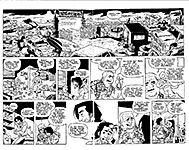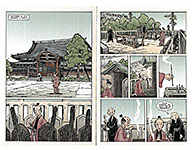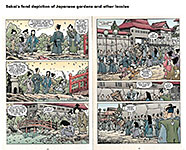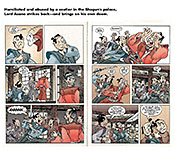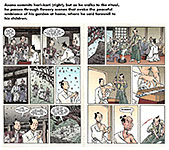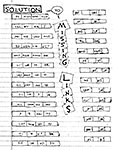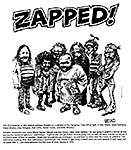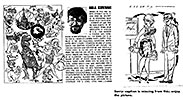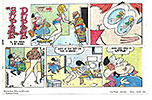 |
|||||||||||||||||||||||||||
Opus 320 (January 30, 2014). A hare-raising behemoth of a posting this time, including a short survey of a few of the comics events of 2013, Stan Lee’s legacy, Rudolph’s red-nosed history, two excellent analytical comics histories (Petersen’s reviewed at conversational length), Will Eisner’s lie and his canny humanity, artist changes at Rex Morgan and Sally Forth, The Nib’s line-up of cartoonists, a cartoon depicting John F. Kennedy being shot at published the morning of the day he was assassinated in the afternoon, classic Phantom Lady reprint, obit for Gary Arlington, and reviews of some current funnybooks (among them, the baffling but metaphysical Shaolin Cowboy) and a dozen books, including The Art of Usagi Yojimbo and 47 Ronin and two David Axe books about wars around the world (one drawn by Matt Bors; the other, by Tim Hamilton). Much of the foregoing transpires during a conversational ramble as we wander off into several colorful detours and byways —discovering astounding histories and amusing gossip, a regular bull session like those of yore. Here’s what’s here, in order, by department—:
NOUS R US Islamic Hooligans, Jesus and Mo Comic-Con Cancels 4-Day Badge Artist Changes at Rex Morgan and Sally Forth Russ Heath to Get NCS Caniff Award 1960s Batman DVD History of Rudolph the Red-nosed Cal Grondahl Laid Off Matt Bors Announces Line-up at The Nib CBLDF Lists Bannable Offenses Year of the Horse at Dark Horse Stan Lee on TV, plus His Legacy Analyzed CELEBRATING COVER ART
THE YEAR JUST PAST Modern World’s Summary of Events Notable Statistics BEST COMICS SELLERS OF THE YEAR Word(s) of the Year Jack in the Box (Cartoon Shooting Kennedy)
Jivey Puzzle
NEWSPAPER COMICS PAGE VIGIL Artists on Starbuck Jones in Winkerbean Various Strips Commented Upon (Baldo, One Big Happy, Blondie, Xmas Strips, New Year, Pearls, Pickles)
BOOK MARQUEE Sin City Omnibus Forthcoming BECY Out in March Alter Ego No.122 on CBG Cartoons of World War II The Complete Colonel Blimp The Best of the Comix Book Bad Girls Need Love Too Classic Phantom Lady: Volume One This Book Contains Graphic Language The Art of Usagi Yojimbo BOOK REVIEWS
Comics, Manga and Graphic Novels (Will Eisner: A Dreamer’s Life in Comics; brief) The Other Thing About Eisner
LONG FORM PAGINATED CARTOON STRIPS Army of God War Is Boring
FUNNYBOOK FAN FARE Captain Midnight Shaolin Cowboy Damian Criminal Macabre: Eyes of Frankenstein Daredevil No.24, 25 Tom Strong The Saviors 47 Ronin (5-issue series) Stan Sakai’s Plight
ONWARD THE SPREADING PUNDITRY Jivey Puzzle Solution
PASSIN’ THROUGH Morrie Turner Gary Arlington Bill Kresse
Our Motto: It takes all kinds. Live and let live. Wear glasses if you need ’em. But it’s hard to live by this axiom in the Age of Tea Baggers, so we’ve added another motto:.
Seven days without comics makes one weak. (You can’t have too many mottos.)
And our customary reminder: don’t forget to activate the “Bathroom Button” by clicking on the “print friendly version” so you can print off a copy of just this installment for reading later, at your leisure while enthroned. Without further adieu, then, here we go—:
NOUS R US Some of All the News That Gives Us Fits
ISLAMIC HOOLIGANS A-PROWL From english.aharm.org.eg/NewsContent: One of the most influential Islamic organizations in the UK has slammed a website, “Jesus and Mo,” that posts cartoons featuring Jesus and Mohamed in a comic strip in which the two prophets debate and joke about the central tenets of Christianity and Islam. The Muslim Association of Britain (MAB) called the images "extremely offensive to believers" of the two faiths and "potentially inflammatory," and urged the website's operators to take down the comics at once. They declined. The MAB added that the depiction of the two prophets was “as insulting as those published in Denmark," referring to the 12 editorial cartoons depicting Prophet Mohamed that were printed in a Danish newspaper in 2005, sparking widespread anger and protests that resulted in scores of deaths. The site's most-recent comic, from January 15, shows Prophet Mohamed and Jesus in bed together, with Prophet Mohamed reading the Bible and grilling Jesus over the believability of the resurrection. Insisting that it respects freedom of speech and artistic expression, the MAB however questioned "the wisdom of any individual or organization that places at risk the dignity and values of anyone else, even if they might not hold those values." RCH: Once again, Muslims (and they aren’t alone in this) have a mistaken idea about freedom of speech and expression. These freedoms do not exist in order to guarantee dignity or the values of anyone—except the value of freedom.
COMIC-CON WITH ITS HANDS IN YOUR POCKET From Noelen Clark at herocomplex.latimes.com (with my italicized sniping wedged in): The Comic-Con International San Diego has eliminated the four-day badge for this year’s Con, July 24-27. That means you must buy a badge for each of the four days. The four-day registration was offered at a discounted price, so that savings has gone away. And the Con pockets it. Con officials explain this maneuver by saying it will give attendees “greater flexibility.” (And I say: Conniving politicians usually explain a self-serving gouging innovation by saying it will benefit those who are being gouged, and the Con’s explanation belongs solidly in this dubious tradition.) In its official blog, the Con saith: “The 4-day option was repetitive and often lead to people purchasing a 4-day badge despite not needing to attend every day. We hope this change will allow attendees to purchase only the days they truly need and maximize the number of people who can get a badge to attend Comic-Con.” More gobbledegook intended to mask greed as altruism. And yet more grasping: only those who purchase badges for all four days will be eligible to buy a badge for Wednesday’s Preview Night, which is not a stand-alone badge option. Used to be that a 4-day badge got you into Preview Night; now, you’d have to buy 5 one-day badges! To attempt fairness, if, as the Con factotum proclaims, some people bought 4-day badges even knowing they wouldn’t attend all four days (but they’d enjoy a discount that was presumably greater than they’d get buying one-day badges for only the days they wanted to attend)—if that’s the case, then this new procedure will presumably make it possible for more people to attend. The Con has been “sold out” the year before several of the recent festivities; and “sold out” may mean that the 4-day badges were all gone. Now, with people having to buy a badge for each day, it is supposed that some days otherwise blanketed by 4-day passes will be open for more one-day badge purchasers. Still sounds like greed to me, though.
CHANGES AT VENERABLE STRIP DRAWING BOARDS. At Rex Morgan MD, written by Woody Wilson, artist Graham Nolan, who has drawn the strip for 14 years, has stepped away to concentrate on other projects, passing the brush and pen to Terry Beatty, reported Alan Gardner at DailyCartoonist.com: “Terry has been the artist for King Feature’s The Phantom since January of 2012 and he’ll continue to draw the iconic feature. Terry’s work on the Rex dailies started December 30; his first Sunday was January 12. On a blog post, Terry indicates he wasn’t given a lot of time to adopt Graham’s style and readers should allow a certain amount of time for him to settle into the duties – which I think is reasonable. Terry writes: ‘I take my work on Rex very seriously, and am giving it everything I have — even while fighting a vicious case of bronchitis, as I have been for over a week now (yes, I’ve seen a doctor; I’m on meds, etc.). Any new artist coming on to the strip would have an adjustment period in which the character designs will shift — some more than others. That happened to me on The Phantom as well — it just took a little while for “my” Phantom to emerge. The same natural process is happening with Rex — and just as it took readers a while to accept the change in style from Tony DiPreta’s work when Graham Nolan came on board, it’s going to take a while for some folks to accept me. I’m okay with that. ‘Some have suggested that I should have taken more time to practice drawing the characters before taking over the art. That’s a lovely idea, in theory — but in reality, I was hired to draw the strip — and then — had to start drawing the strip. There was no great block of time beforehand for me to “warm up.” It’s the nature of newspaper strips that they have to be done and delivered no matter how tight the deadline. And I had to hit the ground running here to keep things on schedule.’” And at Sally Forth, the drawing chores were taken over last spring by Jim Keefe —the dailies with the March 11 release; the Sundays, April 7. Keefe, after attending the Joe Kubert School, colored strips at King Features from January 1996 to March 2003. At the same time, he was also drawing and writing Flash Gordon, it sez here (Wikipedia). He left the coloring assignment at King Features bullpen “for economic reasons.” Then he connected with Craig MacIntosh, who was drawing Sally, and worked as his assistant, inking and coloring the Sundays. “When Craig decided to retire last year,” Keefe said, “I worked up some samples (under his watchful eye) which were then submitted to King Features. After navigating the proper channels, the word was given from on high (editorial approval), and I was given the green light.” The last time Sally changed artists—when MacIntosh came aboard—the change inspired hue and cry among faithful readers, who noticed that Mac’s drawing was superior to that of Greg Howard, who originated the strip in 1982 and wrote and drew it for nearly ten years. In startled reaction, MacIntosh immediately fell back and began deliberately imitating Howard’s simpler, more rudimentary style; he gradually eased off it and eventually resumed his own mannerisms. It was the sudden, overnight, change in the strip’s appearance that fired up the reader protest. With Keefe, however, the transition has been virtually unnoticeable (well, I didn’t notice). Keefe’s also good at more realistic, heroic-style rendering, as you can see from the Flash Gordon sketch in the corner of your eye—and next to it, Keefe’s cover for the December issue of Comics Revue, depicting Tarzan, Mandrake, Modesty Blaise, Flash, Steve Canyon, and the Phantom, all starring in their own eponymous strips in every issue of Rick Norwood’s monthly magazine reprinting celebrated comic strips.
Others in the magazine’s line-up: Buz Sawyer, Alley Oop, Gasoline Alley, Rick O’Shay. Subscriptions, $59/year (6 double-issues); Manuscript Press, P.O. Box 336, Mountain Home, TN 37684. Howard continued writing the strip until 1999, when he handed it off to the current writer, Francesco Marciuliano.
ROUND-UP Russ Heath, perhaps best known for his authentic work in DC Comics’ war titles such as G.I. Combat, Our Army at War, and Star Spangled War Stories, will receive the National Cartoonists Society’s Milton Caniff Lifetime Achievement Award at this year’s Reuben awards celebration—in San Diego, over Memorial Day weekend, May 23-25. Heath began his career in comics at age sixteen when he inked a story entitled “Hammerhead Hawley” for the April 1944 issue of Captain Aero Comics. In 1946 he joined Timely Comics (Marvel), mostly illustrating western characters such as Two-Gun Kid and Kid Colt. “Holy nostalgia, Caped Crusader!” Brian Truitt said in USA Today, recognizing the forthcoming home-video release of the original 1966-68 “Batman” tv show. Famed for its light-hearted campy approach to the Dark Knight, the show starred Adam West as Batman/Bruce Wayne and Burt Ward as Robin/Dick Grayson. It ran twice a week—Tuesdays and Thursdays, as I recall—and was relished for its roster of colorful villains, all lifted from four-color pulp and enacted by notable thesbians: the Joker (Cesar Romero), the Penguin (Burgess Meredith), the Riddler (Frank Gorshin) and three different women to wear the tight leather of Catwoman (Lee Meriwether, Eartha Kitt and Julie Newmar). “Celebrities of the day were regular guest stars, including film director Otto Preminger as Mr. Freeze, Milton Berle as Louie the Lilac, Vincent Price as Egghead, Liberace as Chandell and his twin brother Harry, and Zsa Zsa Gabor as Minerva.” And they all looked as if they were having the time of their lives playing such extreme characters in a never-very-serious show. Weekend Cartoons. Parade, the Sunday newspaper supplement, has an on-again off-again record with its “Cartoon Parade” feature. Some weeks, no cartoon; others, one or two. Altogether, a pretty feeble showing where we used to see an entire column of 3-4 cartoons. One Sunday, I noticed that the other Sunday supplement, USA Weekend, published a cartoon. It was on the “Fun” (puzzle) page so it’s not a very large deal. My hopes soared but were dashed over the next couple Sundays: no more cartoons. The “Fun” page ’toon was a fluke. Until the January 17-19 issue, when it published another cartoon. Dunno whether to cheer or weep.
RANKIN/BASS’S “ANIMAGIC” PUPPET FILM “Rudolph the Red-nosed Reindeer” is the most-watched Christmas special on tv. But that’s not the whole story. From Wikipedia: Rudolph was created in 1939 by advertising copy writer Robert L. May as an assignment from his employer, Montgomery Ward. The retailer had been buying and giving away coloring books for Christmas every year as a good will gesture, and it was decided that creating its own book would save money. May considered naming the reindeer "Rollo" and "Reginald" before deciding on "Rudolph." In its first year of publication, 2.5 million copies of Rudolph's story were distributed by Montgomery Ward. May’s story was written as a poem in the meter of ’Twas the Night Before Christmas. Unfortunately, May ran immediately into a prejudice against red noses, which, in the popular mind, were closely associated with chronic alcoholism and drunkards, and so the story idea was initially rejected. May asked his illustrator friend at Wards, Denver Gillen, to draw a "cute reindeer,” using zoo deer as models. The alert, bouncy character that Gillen developed convinced management to support the idea. Montgomery Ward stopped giving out Rudolph coloring books in 1947, and May acquired the copyright to his creation. Then May’s brother-in-law, veteran composer Johnny Marks, started adapting the story of Rudolph into a song. Gene Autry's 1949 recording of the song hit No.1 on the Billboard pop singles chart the week of Christmas that year. Autry's recording sold 2.5 million copies the first year, eventually selling a total of 25 million, and it remained the second best-selling record of all time until the 1980s. Maxton Books published the first mass-market edition of Rudolph and also published a sequel, Rudolph the Red-Nosed Reindeer Shines Again in 1954. In 1991 Applewood Books published Rudolph's Second Christmas, an unpublished sequel that Robert May wrote in 1947. In 2003, Penguin Books issued a reprint version of the original Rudolph the Red-Nosed Reindeer with new artwork by Lisa Papp. Penguin also reprinted May's sequels Rudolph Shines Again and Rudolph's Second Christmas (now retitled Rudolph to the Rescue). May died in 1976, having enjoyed about three decades of royalties.
ANOTHER EDITOONIST RAPTURED From Tony Semerad at the Salt Lake Tribune: Iconic Utah editorial cartoonist Cal Grondahl was among as many as a dozen newspaper staffers let go January 10 at Ogden’s Standard-Examiner. Grondahl, 63, said that Executive Editor Andy Howell had informed him "they were closing out the position," and the veteran cartoonist walked out after 28 years on staff. The layoffs, reportedly affecting news-gathering and support positions, follow deep staffing cuts at the Salt Lake Tribune in September and at the Mormon church-owned Deseret News more than three years ago — all in the face of declining print circulation and advertising revenue. Said Grondahl: "They told me it had nothing to do with the quality of my work. I don’t know what the numbers are but I hear the rumors. They have to make some hard decisions. I can see that." Known for his mordant caricatures of Utah and Mormon culture and Ogden’s political scene, Grondahl was a popular fixture on the newspaper’s editorial pages. Right around here, we’ve posted a short retrospective of his work, which reveals several stylistic changes over the years: pencil and wash in the late 1980s, lively untoned penline in the early 1990s, and, today, bold outlines and brilliant (not to say garish) colors.
"He does a unique job on what are sometimes sharp and emotional issues," said Ogden Mayor Mike Caldwell, who acknowledged he had collected every one of Grondahl’s cartoons of him. "He’s brought a sense of comedy and lightness and reminded us never to take ourselves too seriously." Editor Howell called Grondahl "an institution" and said the newspaper was pursuing several proposals to continue working with him on a contractual basis. Grondahl is also an author and is considered the respected elder of a cadre of Utah cartoonists who trained at Brigham Young University, among them Pulitzer Prize winner Steve Benson at the Arizona Republic and Pat Bagley at the Salt Lake Tribune.
MATT BORS’ THE NIB GETS A LINE-UP By Matt Bors When I began editing at [the website] Medium a few months ago, my goal was to make The Nib the destination for good political cartoons, comics journalism, humor and non-fiction. On January 6th, I moved closer to that with the launch of a huge regular lineup that will see over 15 cartoons added to the collection every week. Monday will feature new comics from Liza Donnelly of The New Yorker and Rich Stevens of Diesel Sweeties, along with Ruben Bolling’s masterful Tom The Dancing Bug. Tuesday will see new work from Lulu Eightball creator Emily Flake, Brian McFadden of The New York Times, and myself. Wednesday will be Zach Weiner, the man behind Saturday Morning Breakfast Cereal, political cartoons from J.J. McCullough, and Tom Tomorrow’s long running alt-weekly staple This Modern World. Thursday will feature Jen Sorensen’s Slowpoke, chart-like charts by Disalmanac creator Scott Bateman, and Erika Moen’s Oh Joy, Sex Toy reviewing everything related to sex, sexuality and the sex industry. Friday: New Three Word Phrase comics by Ryan Pequin, editorial cartoons by Ted Rall, and new one panels and Too Much Coffee Man strips from Shannon Wheeler. I’ll also be publishing longer comics journalism and non-fiction every week. Susie Cagle will be contributing twice a month, covering the influx of Silicon Valley tech money that’s riling and reshaping the San Francisco Bay Area, from its streets to its culture. Andy Warner will be posting his series “Brief Histories of Everyday Objects” as well as comics journalism examining the odd, the obscure and the eccentric, like “Australia is a Gigantic Sponge.” Julia Wertz will be contributing autobiography. There will be new comics journalism from Josh Neufeld. Keith Knight will be contributing an original comic every month and I’ll be running editorial cartoons from Signe Wilkinson, Adam Zyglis, Pat Bagley, and Mike Lester. There will be comics this year from Sarah Glidden, Lucy Bellwood, Darryl Holliday and Erik Rodriguez, Ron Wimberly, Blue Delliquanti, Jess Ruliffson, Zohar Lazar, Leigh Cowart and Jeannette Langmead, Jon Rosenberg, Wendy MacNaughton, Jack Ohman, Emi Gennis, and John Martz. A good start.
HOW TO GET A FUNNYBOOK BANNED The Comic Book Legal Defense Fund published last year a list of “banned comics.” Libraries, while zealous (and rightly so) in protecting their right to have whatever books they want on their shelves, have encountered problems with comics: as the four-color fictions “become a more important part of today’s library environment, they are increasingly vulnerable to challenges and bans, especially because of the medium’s visual nature.” In most instances, my bet is that the “challenges” that result in “bans” originate with parents rather than librarians, who are usually advocates of free speech and expression. Here is a list of the offenses comics have supposedly committed lately and some of the titles that committed them, assembled by Tim Leong: cited for having offensive language— Batman: The Dark Knight Strikes Again (also “bigotry”), Ice Haven, Persepolis, Sandman (also “anti-family”); cited for obscene images—Fun Home, Blankets (two undisputed masterpieces of comics art); drinking/smoking/drugs—Bone (!!!); bigotry—Maus (well, sure: it was about bigotry but I don’t think many readers would think Art Spiegelman was advocating prejudice); nudity—DragonBall, In the Night Kitchen (an old offender; the little kid is naked, remember?), Tank Girl, The Color of Earth.
2014 DECLARED “THE YEAR OF THE HORSE” Dark Horse Loses Star Wars But Isn’t Weeping IN DECLARING 2014 “The Year of the Horse,” Dark Horse wasn’t just alluding to the Chinese Zodiac: interviewed by Kiel Phegley at ComicBookResources.com, publisher Mike Richardson and editor-in-chief Scott Allie outlined an ambitious publishing schedule for the year, touting the company’s unique ability to provide creators the support they want with original material (f’instance Elfquest, The Witcher—based on a video game—and Veil) and their innovative licensed comics program with new launches for Tomb Raider, Ridley Scott's Prometheus and more, as well as perennial anchor books like Joss Whedon's Buffy The Vampire Slayer and Mike Mignola's Hellboy. Protesting the rumor that Dark Horse is in serious trouble since losing the Star Wars franchise to Disney, Richardson said: “Well, we've known for a long time that Star Wars was going. We couldn't announce it until Lucasfilm was ready, and they picked the day of January 3, allowing us to get through the holidays without having to deal with it. But we've known this for a very long time as we've built our schedule. The thing that's a little bit irritating is hearing this talk of ‘Well, Dark Horse can't get by without Star Wars.’ Star Wars constituted less than 6% of our bottom line. We're talking a year in which we've had a sensational year. So we're fine without Star Wars. The bigger blow here is not to our checkbook but to our psyche because we chased Star Wars originally because we were big time fanboys. We treated that as a very precious property, and it's sad to lose it. That's the sad part of it. But the financial part has very little effect on us.” The rumor, Richardson said, started because “Star Wars is such a huge cultural phenomenon and now with Disney [bringing out new installments of the epic] it's been back in play, and I think people just assumed it must be the juggernaut here at Dark Horse, but we have a number of programs that are every bit as big, some bigger. So we're sad to lose it, but maybe it's a good time to lose it as Disney takes over Lucasfilm and seems to be heading in a different direction.” “So this is the best overall year we've ever had,” he continued, “and we’re in really good shape. We have a new creator initiative that we'll be rolling out across the year that will help make it an easy choice for creators to bring their projects here. ... Overall, with the year 2014, we'll have announcements all year with exciting new creators—both big name people coming to work on projects and a new creator-owned initiative. The licensed properties on our publishing schedule will be as exciting as ever from Fox to game-based properties like Mass Effect, Halo and others. And there will be some new company owned projects that we've started in recent months. All of it looks very exciting.” Dark Horse will continue what it’s been doing that has made it the third largest comics publisher in the country: “Since the very beginning,” Richardson said, “we've looked for creators with unique talents and visions. We're not just trying to find more of the same. I always felt the creator-owned line was more for the readers who had graduated from Marvel and DC comics and were looking for something new in order to stay excited in the market. There was a study years ago that said the average Marvel reader goes in and out of the market within three or four years. Our goal early at Dark Horse was to try and capture those readers. We want books that will keep readers in the market.” Richardson voiced a mild protest against disparaging remarks about licensed comics: “I hear the term "licensed comics" all the time as though there's some strike against them if they're based on a media property. Remember that Superman, Batman, Spider-Man, the Fantastic Four—none of those are done by their creators. They're all owned by corporations, so I can't see what the difference is between a Superman comic and one of our licensed comics in terms of its organic basis. Whether it be video games, television, films or whatever, every good story has great potential as a comic. We've had great success with our Aliens stories back in the day and heard from all over that we brought new readers in with Alien Vs. Predator. So where things come from is not a key factor in whether it can be successful or not.” Editor Allie chimed in: “For me, working on the Buffy comics is a lot like working on Hellboy. You've got to make sure you're true to the creator's vision and that you're sticking to what the thing is all about. It's the same with the Prometheus comics where Mike has been working with Ridley Scott to make sure that what we're doing connects with where Ridley's heading with the rest of the franchise.” Both Dark Horse stalwarts Mike Mignola and Stan Sakai have new material on tap for the coming year. Said Allie: “The Mignola stuff is really fun and it does change and grow over the years. Mike, John [Arcudi] and I talk all the time, and we're always brainstorming stuff. Mike has always had a long vision for where all this stuff is going, but it's flexible and it changes. I think one of the really appealing things about those books is that you get the sense that this story is really going somewhere—and it is! But sometimes it changes, but we stick to the core principals. It stays fresh for us because of the way it evolves and because we bring new artists in. There are a lot of characters that Mike comes up with that we don't think are going to be a big deal, but they become a big deal for the readers. Sledgehammer is a character we did five issues with, the last of which comes out this month, and we didn't realize how much of a big thing that was going to be the first time Guy Davis drew it in the background of one panel in a book called The Dead. But it stuck around, and we thought about more ways to play with it.” Richardson spoke about Sakai: “It's interesting with Stan because Stan really likes doing Usagi. When we did 47 Ronin [see review down the scroll], he had to think about it because it meant he had to step away from Usagi for a while, but suddenly he realized he really wanted to do it. I'd been thinking of who could do that for 20 years, and I finally got serious about it because this movie was coming out that's not exactly faithful to the legend. We wanted to tell the real story, and when I told it to Stan, he thought it was a great idea. I don't think he'd ever done people [humans not anthropomorphic animals] in comics for an extended period of time, and he had the perfect style for this book. It recalled Japanese woodcuts without being a slave to that particular style of art. I think he's now dying to get back to Usagi, and when I read the reviews of 47 Ronin— which was reviewed well mostly thanks to Stan—a lot of the reviewers said, ‘We're so glad this is over so Stan can get back to doing what he's supposed to be doing.’ [Laughs] I think he's going to be doing it for a long time. He's a tremendous artist and a tremendous person too. It's such a pleasure to have him here at Dark Horse.” Summing up, Richardson repeated that Dark Horse is in fine financial shape, the departure of Star Wards clearly notwithstanding: “One of the impressions given about Dark Horse I think comes from that Diamond pie chart, which has always been an irritant. I'm not sure, but I think that's what people think of as the measure of our company's success. But when one company publishes 90 pamphlet comic books and another company publishes 40, but the 40-comic publisher has a much higher per issue sales value—well, I'm not sure what that market share chart means. And that doesn't even include backlist or bookstore sales where we are incredibly strong. It doesn't include products or all the other divisions. Dark Horse is unlike any other comic book company out there. We have very clear and profitable divisions, we're known for quality, and we continue to grow every year. People can buy market share or flood the market, but that's never our goal. Our goal is always to grow each year with quality product and to be specific and careful in the choices we make and the creators we go after. While we're not always 100% in that, I think our ratio of success is pretty high. And that's what'll continue in 2014.”
STAN LEE FOREVER Stan the Man is up to his usual shenanigans, but this time instead of getting his name in print, he’s getting his face on film. The Hollywood Reporter says: “After weeks of speculation, Stan Lee has confirmed that he will appear in an upcoming episode of ABC’s Marvel’s ‘Agents of SHIELD.’ While details on just whom he will play are unclear, Lee — who also serves as an executive producer on the freshman series — says that it’s a ‘big role.’ The episode will most likely air February 4, though that is subject to change.” All of which brings up the ever-lurking question about what Stan Lee did to deserve all this attention, feverishly fawning as well as ferociously condemnatory. At ComicsAlliance.com, Chris Sims tries to discern Stan Lee’s “actual legacy,” which immediately entangles him in the usual thicket of disputation about Lee’s hogging the credit for creating Spider-Man, the Fantastic Four, and so on. Sims does a more than fair job of sorting it all out, and his whole essay (Ask Chris #178) is worth a read. Here are some of the highlights—: I think we all have a lot of complicated feelings about Stan Lee. Depending on who you ask, when you ask them and what he’s been up to lately, he’s a conniving credit-stealer, a shameless self-promotion machine, a “driven little man who dreams of having it all!!!” and got it by coasting on the hard work of others, or he’s a charismatic innovator who got put into that spotlight because he’s a natural showman, a smiling ambassador of the medium and everybody’s friendly comics grandpa. And it’s further complicated because you can’t really talk about him without talking about collaborators like Jack Kirby and Steve Ditko, either. That’s what makes him hard to talk about, even if you’ve spent nearly your entire life being aware of him. There’s just so much to get through that’s filtered through so many angles, and as a result, I genuinely think that he’s simultaneously the most overrated and underrated creator of all time. Let’s start with this: I say that he’s underrated because it is almost impossible to overstate his contributions to the medium. There’s a huge segment of die-hard fans and creators that fall all over themselves to minimize his contributions in favor of glorifying Kirby, and it’s easy to see why: It’s literally impossible to overstate Kirby’s contributions, and he’s the one who never got the attention that Lee’s been reveling in for the past fifty years. But to claim that Lee wasn’t a vital ingredient in those early years of Marvel, or that he didn’t have value as a figurehead for the company well after he finally handed Amazing Spider-Man off to Gerry Conway is a disservice to both men, and it’s something history doesn’t really support. I mean, don’t get me wrong, you’re an absolute lunatic if you don’t think Kirby was doing the vast majority of the work in their partnership, but still, it’s not quite as one-sided for either man as some folks would have you believe. ... Even if he and Kirby didn’t have their plotting sessions, even if we didn’t know that he was the one arguing with Ditko about wanting the Green Goblin to be revealed as Norman Osborn to give Spider-Man a personal connection to his greatest enemy, there’s still a lot there. In the bare minimum, he was still writing dialogue, assisted or not, for every Marvel comic, doing his best to add depth to those stories and build the connecting storylines that set Marvel apart from the competition. Obviously, it’s not perfect by any stretch of the imagination ... Point being, Lee’s writing leaves a whole hell of a lot to be desired once you get outside of that lightning-in-a-bottle era where Marvel was redefining superhero comics with Lee arguably at the helm. You can look back on all that breathless dialogue from the early days and have a laugh at its expense, but compared to the house style of DC’s scripts, it was a revelation. It seems hokey now, but so does Denny O’Neil’s dialogue in Hard Traveling Heroes, and hell, so does a lot of Frank Miller’s dialogue, and we’ve had 30 solid years of people trying to recreate that to get used to it. Again, at the bare minimum, Lee was a big part of something that redefined a genre. If the tradeoff for those first 100 issues each of Fantastic Four and Amazing Spider-Man is the occasional Mighty 7, then it’s a trade I’m willing to make. But that’s just Stan Lee the Writer. Like I said, bare mininum, if that’s all he did, it’s still a pretty impressive contribution to the medium. But the thing is, that’s not all he did. Not by a long shot. Stan Lee’s greatest talent, for good or ill, was never writing comics, or even editing them. It was promotion.
THE REAL MAGIC OF STAN LEE’S CONTRIBUTION to Marvel wasn’t just filling Kirby and Ditko’s panels with five-dollar words and screeds against the commies. It was that brash, aggressive style that put a face (not coincidentally, his own) behind the comics. From very early on, the letters pages were clear to let readers know that “Stan and Jack” were the ones behind the adventures of the Fantastic Four, and again, you can’t really overstate how revolutionary that was. This was a time when creators were rarely if ever credited, but Lee — ironically, given the reputation that would come out over the years for stealing credit and hogging attention — was part of the crowd putting their names right there on page one. Because of that ease in identifying just who it was that made these books, and because Lee took space in each issue to hype up Marvel’s offerings, take pot-shots at the competition and compliment Marvel readers on their excellent taste in reading Marvel comics, there was a personality behind those books, and, oddly enough, knowing more about the people who made the stories also makes them feel more real. And because Lee was the one handling the words for the most part while Kirby and Ditko were going full-tilt at the drawing board doing the lion’s share of the work, Lee was that personality. He was the one answering letters and shilling the books and using that bombastic style of his to charm readers and interviewers. Kirby might’ve been Marvel’s heart, but Lee was Marvel’s mouth in every way that mattered. (Ditko was, I don’t know, its weird elongated fingers.) That is Stan Lee’s greatest contribution. He was the pioneer of that bombastic style of good-natured self-aggrandizement and confrontational salesmanship that’s still represented in the way Marvel presents itself to this very day. By getting out there, by making himself the focus, he became as much of a character, as much of a product, as the comics. He was a marketable commodity, and he sold very well. ... It’s worth noting that the general public has never really had a good idea of how comic books work, and that the mass media is more guilty of this than most. Even today, when comics are providing the source material for a gigantic chunk of pop culture that’s raking in billions of dollars, the people who aren’t paying attention to them often don’t quite understand how they work. Tell someone you’re a comic book writer, and there’s a good chance that they’re going to think you’re either something like a prose novelist, spinning an entire story out of whole cloth and then directing an artist as they provide optional illustrations, or that you’re the guy who writes the words in the little balloons. Lee, who, if anything, was probably closer to the latter, was often portrayed as the former.” Sims goes on to recall reporter Nat Freedland’s infamous 1965 New York Herald Tribune article that blew Marvel’s horn—and identified Lee as the maestro bugler. “Needless to say, the article was a sore point with Kirby for years, and was almost immediately followed by Ditko’s departure from Marvel. Lee’s often-repeated story about how he created Spider-Man when he saw a spider and thought it would be “groovy” (he always says “groovy”) if a person had those powers, an origin story that has neglected to mention Ditko every time I’ve heard it, probably didn’t help. To be absolutely fair about it, that’s not entirely Lee’s fault. He played up to it, sure — he’s been playing up to it for half a century now — but you can’t blame him for being an outgoing and naturally charismatic guy. It’s easy to see why Freedland fell into the trap of Lee’s magnetic personality, even if he was grossly irresponsible [as a journalist] as a result. ...
LOOKING BACK, it seems to me that the attention he got took Lee by surprise, and even though you can debate for days about whether he actually tried hard enough to credit his collaborators and was just outdone by a combination of ignorance of the medium and his own charisma, it’s hard to blame him for embracing it. Why wouldn’t he? It was wealth and fame, two things that very, very few people have ever turned down. But that, in turn, is something else that casts him as a villain of sorts — and a very Marvel Comics type of villain too, compared to Ditko’s reclusive, principled loner and Kirby’s imaginative, energetic workhorse. Sean Howe’s Marvel Comics: The Untold Story — which is about as even-handed a recollection as you’re likely to find — paints a picture of Stan Lee that seems like someone who was eager from the start of things to leverage his fame in comics to get into other media, leaving comics behind in favor of magazines, movies, records and stage shows. It’s more than understandable — by the ’70s, Lee had been working in comics for thirty years, going through the boom and bust of the Golden Age and then again in the early days of Marvel. It’s a volatile market, and to put it bluntly, he’d contributed more than enough to be justified in leaving at that point. The problem is that all the ventures he tried to hitch his rising star to attempted recapturing the sense of personality that had brought such success at Marvel — only now, it manifested as an element glorifying Lee himself.” Lee, Howe says at one point, is “the first comic book author to gain celebrity status.” [And no journalist is likely to overlook that fact, and the more blatant it become, the more attention Lee got.—RCH] Sims continues: It’s not hard to draw a straight line from fiascos like that to the ongoing eye-rolling saga that is Stan Lee Media, a company that Lee himself is no longer associated with, but that he sold his name to in a bid for new media fame. Howe covers that, too, and folks, if you don’t think that story involves defrauding Fidel Castro and people fleeing the country with a quarter of a million dollars in cash at one point, you really need to get that book. Again, it’s hard to blame Lee, because again, who’s going to turn down that level of fame? Who’s going to not want to get into the thriving movie industry when he’s been through comics collapsing twice at that point in his life? But when you combine it all, the hunger for stardom, the tendency to glory in the attention, the self-deprecating attitude towards the genre and medium that he helped revolutionize, the minimizing — intentional or otherwise — of the contributions of others, it’s easy to see how we arrived at the caricature of Lee the glory-hound, the pitch-man and promoter that he’s become instead of the creator that he was. ... Yet again, you can’t lay the blame for all of that at Lee’s feet. Yes, he’s the one who shows up in the movies; yes, he’s the one with a convention named after him; yes, he’s the one that’s always in the media being credited erroneously, but that’s largely a function of the fact that he’s still alive. Ditko is still alive and still producing comics, but he’s made it clear in no uncertain terms that he doesn’t want anything to do with Marvel, even going so far as to legendarily use his original art from Spider-Man as cutting boards. If Kirby was still alive, I’m sure he’d be doing interviews and making cameos in the Avengers movie too, but he’s not. Stan Lee is, and as much as it might fuel that public perception of his godlike role as a creator, there’s nothing wrong with respecting his accomplishments. Besides, at 91 years old, you’d probably stop correcting people too. If I live that long, I’mgoing to claim to have created Spider-Man all by myself. So what’s his legacy? Well, as someone who tries really hard to be an optimist, I’d like to hope it’ll be closer to the first half of this essay than the second. Lee, for all his many flaws, for all the funky flashiness that drew attention away from the people who deserved it just as much as he did, was a driving force in shaping superhero comics and through them, pop culture as we know it. I might be a Kirby partisan — I am a Kirby partisan, if we’re going to start fighting that fight — but minimizing Lee’s contributions to the medium doesn’t fix anything. It just wouldn’t hurt to look at it all with a slightly more critical eye.
Fascinating Footnit. For even more comics news, consult these four other sites: Mark Evanier’s povonline.com, Alan Gardner’s DailyCartoonist.com, Tom Spurgeon’s comicsreporter.com, and Michael Cavna at voices.washingtonpost.com./comic-riffs . For delving into the history of our beloved medium, you can’t go wrong by visiting Allan Holtz’s strippersguide.blogspot.com, where Allan regularly posts rare findings from his forays into the vast reaches of newspaper microfilm files hither and yon.
QUOTES AND MOTS ■ From Candorville’s Darrin Bell: Proof that my iPhone is racist, No.246—: Autocorrect learns in part by watching which words you type over and over. There's one word I've never typed on this phone, because it's a word I never use. Yet just now, I wrote the words "chicken nuggets" in a text, and my iPhone autocorrected it to "chicken (n-word)." ■ Possibly from Playboy/New Yorker cartoonist Eldon Dedini: “Why do they put pictures of criminals in the Post Office? What are we supposed to do—write them? Why don’t they just put their pictures on the postage stamps so the mailmen can look for them while they deliver the mail?”
CELEBRATING COVER ART You may have noticed that the artwork in comic books has been getting better and better for the last three decades. It is now, without quibble, simply superb. Inside and outside, funnybooks are better drawn than they’ve ever been. Comic book publishers, however, have committed a strategic mistake. They hire super-star artists to render the covers of the comics; the interior pages are drawn by your everyday graphic geniuses, but the covers are reserved for celebrity artists. It’s a marketing ploy. The assumption is that you’ll buy a comic book for its cover art: if it’s spectacular, you’ll dig deep and buy it and take it home to drool over. But if that’s your reason for buying a book, there’s a less expensive way to achieve the same result. Just get Diamond’s monthly catalogue, Previews, and tear out the pages printing the covers you find attractive. This’ll work for DC, Marvel and Dark Horse, all of whose covers as a rule get full–page treatment. It won’t work for the smaller publishers whose covers are printed at postage-stamp size. But DC, Marvel and Dark Horse have the most blatant celebrity-drawn covers anyhow. And the savings you’ll achieve by this strategy will be significant—assuming, that is, that you are one of those who buy comics for their cover art. Here are a few of the covers from the most recent Previews that tempted me to buy the issues they covered; but instead, having conjured up this money-saving ploy, I’m hoarding just the covers.
EDITOONERY The Mock in Democracy Will return next time in Opus 321 (probably about the end of January).
THE YEAR JUST PAST Play the Oboe and Bagpipes Merrily MOST SO-CALLED JOURNALISTIC ENTERPRISES muster their year-end features around Christmas so’s to have their celebration of the Year Just Past out-and-about when the year actually ends. But what if something earth-quaking were to happen between Christmas and New Year’s? Those over-eager wannabees would miss it, that’s what. Their picture of the Year Just Past would be catastrophically incomplete. They’d stand revealed as the over-eager frauds and jack-booted phonies that they are. Here at the Rancid Raves Intergalactic Wurlitzer, we’re much more scrupulous: we wait until the year is actually over, completely over, so our survey of the Year Just Past will be thorough, based upon a careful study of everything that happened in 2013, everything up to and including the very last minute. As it turns out, nothing much happened between Christmas and New Year’s, and New Year’s Eve itself—the last day of the Year Just Past—was particularly uneventful, as usual. The wife and I stayed up until midnight, which was our once-a-year indulgence. Sipped a glass of champagne and ate smoked oysters on toothpicks. We missed the Dropping of The Ball on Times Square. We’re two hours later out here in the woolly wilds of Colorado, so we should have had the tv on at 10 o’clock. Instead, we were watching a movie at that time. We eventually tuned in to Dave Letterman, but I think his show was a repeat. So even though we stayed up until midnight, we missed the arrival of the New Year. We can, however, report that the rumor, as bandied about all over elsewere, is true: the New Year did arrive, on schedule.
IN OUR EARLY JANUARY BONUS BUNNY, we posted a few editoons on the major political chicaneries and notable social upheavals of 2013, thereby reviewing much of the year. And while we have no intention of plowing all that ground again this time, I can’t resist posting Tom Morrow’s two-part “inadequate look back” by way of reminding you of what a fun year it was for editorial cartooners (who are otherwise absent from this edition of R&R; they’ll be back in a week or so with an “extra”).
Having disposed of the political aspects of the Year Just Past, we’ll move briskly forward to gesture at other facets of the fun year, beginning with a report filed by Robert J. Samuelson, a columnist syndicated by the Washington Post Writers Group. Instead of doing as most other year-end reporters do—assemble lists and rankings—he mustered some Significant Stats, among them—: On a typical day, 3,300 American teenagers smoke their first cigarette. Only 13 percent of students at two-year colleges graduate in two years. A leaf blower with a two-stroke engine emits 299 times the hydrocarbons of a Ford Raptor pickup truck. Half the Republicons in the House of Representatives have served three years or less. (Bunch of amateurs.) A low-end iPhone has 240,000 times the memory of the computers on Voyager 1, which is now nearly 12 billion miles from Earth. Samuelson having broken us out of the pack, we can now turn to Harper’s Index: ■ Percentage change since 2007 in the number of cells in the New York City prison system devoted to solitary confinement: +63 ■ Portion of the adolescent prisoners in solitary on Rikers Island who have been diagnosed with a mental illness: 7/10 ■ Number of U.S. fast-food workers receiving federal and state aid: 942,000 ■ Number of the seventeen people bitten by L.A. Sheriff’s Department dogs in the first half of 2013 who were black or Hispanic: 17 ■ Percentage of black students in Illinois who attend schools where whites make up less than one percent of the student body: 41 ■ Percentage change in the wealth of the average Libyan household in the past year: +61 ■ Of the average Egyptian household: -11 ■ Percentage of Malawians who believe that homosexuality is a “Western invention: 75 ■ Percentage of revenue made on the NFLs pink breast-cancer awareness merchandise that goes to cancer prevention: 11 ■ Portion of all amateur U.S. sports teams with American Indian names at the start of 1970 that have since dropped them: 2/3 ■ Numnber of the seven professional teams with American Indian names at the time that have dropped them: 0 ■ Number of people killed in mass shootings in the United States in 2012: 66 ■ Number killed by Muslim American terrorists since September 11, 2001: 33 ■ Portion of U.S. Jews with Christmas trees in their homes: 1/3 ■ Percentage of American Jews who believe that following Jewish law is essential to Jewish identity: 19 ■ Who believe that have a sense of humor is: 42
IN ITS SUMMARY OF THE YEAR’S EVENTS, People magazine produced prodigious lists—among them, the inevitable “Top Ten” in various of the entertainment media. The one that caught my eye and held it longest is the Top Ten Most Watched Prime-Time TV Shows. Of the ten, only three are scripted fictions: Fox’s “The OT,” CBS’s “NCIS,” and the same network’s “The Big Bang Theory.” Of the remaining seven most-watched shows, three are broadcasts of football games, two are “Dancing with the Stars” and “Dancing with the Stars Results” (which sounds like the same program), and the last two are “American Idol” (Wednesday and Thursday count as two shows it seems). Does that mean the American public prefers reality? I doubt it but so it would seem. If true, it would be a welcome respite from the fake reality espoused by the Tea Party and the rest of the Grandstanding Obstructionist Pachyderm.
OTHER FACTOIDS that surfaced in 2013: ■ Harold Camping, the evangelical radio minister who predicted two or three dates that the world would end, died at age 92 on about December 17 or so. He spread the word of the coming Rapture on more than 5,000 billboards, and some of those who believed his forecast quit their jobs and sold their possessions in preparation for the end. ■ British doctors who carefully read Ian Fleming’s series of James Bond novels say the famed spy regularly drank more than four times the recommended limit of alcohol per week (Associated Press).
IMAGE HAD THE BEST-SELLING comic book and graphic novels in 2013 according to Diamond Distributor’s data. The Walking Dead No.115 was the top selling funnybook, and the same publisher’s Saga, Vol.1 ranked first among graphic novels. ICv2 reports that “Image’s domination of the top graphic novel slots in comic stores was profound”: 6 of the top 10 were Image books, and so was No.10. “Image has also been rocking the bookstore charts: its titles took the top four and nine of the top 20 slots in the December BookScan graphic novel charts.” R.C. Baker at the VillageVoice.com on December 11 listed the year’s “best graphic novels,” beginning with The Best of EC Comics Artist’s Edition, Volume 1—which is not a graphic novel at all. The rest, in order, are: The Adventures of Jodelle (a Fantagraphics’ reprint of the 1966 book); Before Watchmen: Comedian/Rorschach Deluxe Edition; Ray and Joe: The Story of a Man and His Dead Friend (Charles Rodrigues cartoons); Curing the Postmodern Blues; Law of the Desert Born; Sandcastle; Sacrifice; Occupy Comics Nos.1 and 2 (probably not graphic novels); The Alluring Art of Margaret Brundage (ditto); and Battling Boy. I haven’t seen many of these. No surprise: no one who seeks something resembling a normal (that is, not stuck in a chair reading all day) life is likely to have seen everything on anyone else’s “best of the year” list, and I’m no exception, despite my dedication to comics news and reviews. But his rationale for selection seems worth perusing, so visit the website. At entertainment.time.com, Douglas Wolk lists his top ten comics and graphic novels, beginning with Number Ten and working up: Incidents in the Night by David B.; Bad Houses, by Sara Ryan and Carla Speed McNeil; Very Casual: Some Stories, by Michael DeForge; Hand-drying in America by Ben Katchor; Zombo: You Smell of Crime and I’m the Deodorant by Al Ewing and Henry Flint; Boxers & Saints by Gene Luen Yang; Fran by Jim Woodring; Saga by Brian K. Vaughan and Fiona Staples; The Phoenix Weekly Story Comic by various (British, for 7-10 year-olds); and in first place, Sex Criminals by Matt Fraction and Chip Zdarsky. To assess Wolk’s opinion, you need to read his annotations at the website. Sex Criminals, by the way, is demonstrating to a fare-thee-well not only an extraordinary daring in choice of subject (young woman and young man discovering their sexuality together) but the ways that the comics medium can be deployed to explore this subject. Excellent. Besides which, anyone who supposes, as Fraction does, that opposable thumbs evolved in the human (sic) sapiens in order to facilitate masturbation is a philosopher worth listening to. A sexist philosopher but still a philosopher. Another web commentator worth a visit is Lauren Davis at io9.com/10-superhero-webcomics-you-should-be-reading-1497938277, where Davis lists and describes and illustrates the ten superhero webcomics “you should be reading.” A couple of surprises.
My favorite quote of the year. Chip Kidd on Chris Ware’s winning an Eisner for Best Lettering: “Giving Chris Ware an Eisner for lettering is like giving Frank Lloyd Wright an award for doorknobs.”
Word of the Year. The Oxford Dictionary people have denominated “selfie” as the “word of the year.” But the Oxfordians are newcomers to the “word of the year” game: the American Dialect Society has been at it for 24 years, and they say “because” is the word of the year. Or the “verbal expression of the year.” Ben Zimmer, chair of the New Words Committee of ADS, explained: “This past year, the very old word because exploded with new grammatical possibilities in informal online use. No longer does because have to be followed by of or a full clause. Now one often sees tersely worded rationales like ‘because science’ or ‘because reasons.’ You might not go to a party ‘because tired.’ As one advocate put it, because should be Word of the Year ‘because useful.’” ADS also announced the runners-up: slash (as an oral coordinating conjunction meaning “and/or” as in “come and visit slash stay”); twerk (a mode of dance involving vigorous booty-shaking and booty-thrusting, usually with feet planted); Obamcare, and, last, the Oxfordian selfie. ADS has several other variations on the Word of the Year. The Most Outrageous Word of the Year, f’instance, is underbutt ( the underside of buttocks made visible by certain shorts or underwear); and the Least Likely to Succeed—Thanksgivukkah, for the confluence of Thanksgiving and the first day of Hanukkkah (which won’t happen again for another 70,000 years); and the Most Unnecesary—sharknado, a tornado full of sharks, which occurred only in the Syfy Channel movie of that name. Before we leave this gripping topic, I’ve just posted in the adjacent space an example of a selfie, a highly dramatic one, no question, showing off my stubble.
JACK IN THE BOX One of the
Big Events of the year was the 50th anniversary of the assassination
of John F. Kennedy on Friday, November 22, 1963. (Which brings to mind a remark
alleged to have been made by George Carlin: How important does a person have to
be before they are considered assassinated instead of just murdered?) As
November 22 approached, all sorts of commemorations were turned loose on an
unsuspecting public. But the one that fascinated me is about an editorial
cartoon by Tom Engelhardt, which we’ve posted just at your eye’s elbow. A picture may be worth a thousand words, but this one needs some verbal explication, and for that, I’m reprinting Kevin Horrigan’s article from stltoday.com of November 23, 2013. I’ve made a few alterations for the pure sake of clarity; otherwise, what follows next is all Horrigan’s. FIFTY YEARS AGO last Thursday, on November 21, 1963, cartoonist Tom Engelhardt sat down at his drawing board in the editorial page offices of the St. Louis Post-Dispatch. He was then 32 years old, and had been the newspaper’s editorial cartoonist for just over a year. He had an idea for his cartoon for the next day’s paper. President John F. Kennedy was in Texas that Thursday, in San Antonio and Houston, and would spend the night in Fort Worth. The papers were full of speculation that Kennedy would need Texas’ 25 electoral votes in the 1964 election. He’d carried the state over Republican Richard M. Nixon in 1960, largely because he’d named Texas Senator Lyndon B. Johnson as his running mate. But Texas Democrats were having themselves a feud in the fall of 1963. Johnson’s one-time protégé in the party’s conservative wing, John B. Connally, had been elected governor in 1962 and had taken over the state party. Senator Ralph Yarborough, the dean of Texas’ liberal Democrats, couldn’t stand Connally. He wasn’t that crazy about Lyndon Johnson, either. That Thursday, Yarborough refused to ride in the same car with Johnson the next day when they’d all be part of a motorcade taking President Kennedy through downtown Dallas. Kennedy was worried that the split among Texas Democrats would help Republican favorite Senator Barry Goldwater of Arizona carry Texas in the 1964 presidential race. So he went to Texas to raise some money and impose a peace. [And he apparently had some effect:] on Friday morning, Yarborough would grudgingly ride with LBJ. Engelhardt, of course, knew nothing of those seating arrangements when he sat down Thursday afternoon to draw a cartoon about the Texas spat. He is now and was then a gentle man of fierce liberal convictions. If a cartoonist showed you a caricature of Engelhardt, you might guess Fred “Mr.” Rogers. The likeness is close, in demeanor and looks, right down to the skinny ties. Toy cowboys, Engelhardt thought, doodling with his pen. Maybe with little wind-up keys on their back. Exchanging toy gunfire over a worried-looking Jack Kennedy who would be poking his head out of box labeled “Texas 64.” He drew it up and inked it in. “Jack in the Box,” he captioned it. He signed his name and turned it in. Off it went to the composing room to be engraved in zinc and locked into a page form. In those days, the Post-Dispatch was an afternoon paper, a “P.M.” as we say in the trade. That meant the first deadline for the Friday, November 22, paper was 7 a.m. on Friday. That deadline was for the so-called “Bulldog Edition,” a limited press run of about 10,000 papers. The Bulldog was distributed to newsstands, drugstores and grocery stores, where they were sold for 7 cents. The papers came off the presses at 10:30 a.m., whereupon they were bundled, tossed onto trucks and soon were on the streets. A couple of hours later, Engelhardt recalls, “I was eating lunch. I usually carried my lunch so I could eat while reading at my desk. It was about 20 minutes before one o’clock and a copyboy came into the office yelling, ‘Kennedy’s been shot.’” Every American of a certain age remembers our first thought when we heard that news. Very few of us can remember our second thought. I asked Engelhardt how long it took him to realize that there were newspapers on the streets bearing a cartoon, with his name on it, of John Kennedy in a box with gunfire blazing over his head. “It was about a second after he (the copyboy) said it,” Englehardt said. “I felt awful.” When a big story breaks on a newspaper’s deadline, the city room becomes electric. The Kennedy assassination was one of the biggest stories ever, and the Post-Dispatch went to battle stations. One of the first orders given was to send the trucks back out to retrieve and destroy every single copy of the Bulldog edition. A few escaped, but Engelhardt remembers getting only one phone call from a reader. “It was some lady who said, ‘I don’t know how you people know this stuff in advance.’” The zinc plate for “Jack in the Box” was destroyed, too, but not until it was used to make several copies for the Post-Dispatch archives. The copies were in a file labeled “Not to be Given Out.” Engelhardt went back to work that terrible Friday afternoon, drawing for the Saturday and Sunday editions, trying to capture the awful grief of the nation. He would go on to produce 8,050 cartoons in his 35-year career at the Post-Dispatch. He donated most of his original artwork to the State Historical Society of Missouri in Columbia, which has a vast collection of his work and that of his Post-Dispatch predecessors, Daniel F. Fitzpatrick and Bill Mauldin. “Jack in the Box” is there, probably seen by fewer people than any of the others. [Until last November, when Horrigan resurrected it for this article.—RCH] But anyone who’s ever had a really, really bad day at work, for reasons utterly beyond his control — and that’s most of us — will understand why the cartoon is hard to forget.
PERSIFLAGE AND FURBELOWS “The middle of the road is where the white line is—and that’s the worst place to drive.”—Robert Frost “History is the shadow cast by the dead. So long as there’s light, the shadow will fall.”— Jill Lepore in her New Yorker article about Roger Ailes, whose journalistic career maketh history by creating heat rather than light
JIVEY PUZZLE Here’s the solution to Jim Ivey’s puzzle of last time; and next to it, we’ve posted the puzzle itself (in case you forgot it).
And then, immediately below, this Opus’s puzzle, Missing Links, in which you are invited to find in the right-hand column the syllables that should go in the blank spaces on the left to give the names of comic strips. And this time, we’re posting the solution at the end of this Opus so you won’t have to wait for such an unbearable time to find out if you did it right.
READ AND RELISH From editoonist Pat Bagley’s Facebook page: In 1964 Isaac Asimov wrote a piece for the New York Times in which he forecast what the world would look like in 50 years (2014). He bats about .600—actually, pretty good. My favorite part? "The lucky few who can be involved in creative work of any sort will be the true elite of mankind, for they alone will do more than serve a machine." As
if. He didn't foresee that Wall St. would commodisize and outsource everything,
including "creative work", and suck the joy and money out of
everything that draws breath.
NEWSPAPER COMICS PAGE VIGIL The Bump and Grind of Daily Stripping
From Bob Layton (via Facebook): I've had to keep silent for a year about this little project of my pal Tom Batiuk. Fortunately, today's Sunday papers featured my contribution and I can speak freely about it, at last. About a year ago, I was approached by Tom who asked me to contribute to a special storyline in his long running comic strip, Funky Winkerbean. The story involves Funky's wife Holly. Her son Cory is in Afghanistan and she's looking to complete his comic book collection for him as a way of staying in touch. So, she's decides to complete his collection of "Starbuck Jones" comics, which is a character Tom envisioned when he was a wee lad in the fifth grade. It's a fun concept and it was a blast for me to fall back to my "Wally Wood apprentice roots" for the project . The seven artists who created faux comic book covers for this project are Joe Staton, Terry Austin, Mike Gilbert, Neil Vokes, Mike Golden, Norm Breyfogle and myself.
I’VE BEEN
SAYING FOR YEARS that the unique characteristic of the cartooning arts is that
the words and pictures blend for story effects that neither achieves alone
without the other. But comic strips without words also perform superbly
sometimes. Next,
a couple puzzlers. Rick Detorie’s One Big Happy is another kind of puzzler. The story here is that the “evil black bird” scares off the vandals who would have destroyed Ruthie’s snowman. Or so it seems. What then do we make of panel 3? The vandals are at work; the snowman is destroyed. Not so: in panel 4, we see the snowman still in the yard in front of the house as the vandals pause in the street, and the black bird gives them the evil eye—and in the window below, we can just make out Ruthie and her brother Joey, witnessing the threat to their creation. So the next panel, which I’ve numbered 5, is the next logical event: Ruthie and Joey rush to the rescue of the snowman. They arrive (panel 8) after the black bird has done his work (panel 7). All is safe. But that still doesn’t explain panel 3. At first, I thought the panels were out of order. Panel 3 doesn’t belong there. In fact, it doesn’t belong in the continuity at all—unless it’s intended to depict what the vandals are thinking in panel 4; if so, maybe it should come after panel 4. Maybe the correct order would be 1, 2, 4, 3, 6, 5, 7, 8. Who can say? Kelly McNutt and Keith O’Brien, that’s who. I posted this poser on my Facebook page, and both of them pointed out that the snowman being destroyed in panel 3 is not the snowman Ruthie and Joey made: the destroyed snowman has sticks for arms; Ruthie and Joey’s snowman doesn’t. Moreover, in panel 4, we can see both snowmen—the destroyed stick-arm snowman at the upper right-hand corner of the panel. All of a sudden, the strip makes perfect sense. That’ll teach me to be more observant of narrative visual details. And McNutt also pointed out that the joke in Baldo is that the only snow is in the picture Baldo is painting. In the “real” locale, revealed in the final panel, there is no snow. But there are icicles hanging from the roof, so isn’t it winter? Upon close inspection (using a magnifying glass), I see that there are tufts of grass at Baldo’s feet. Why didn’t I notice that before? Because the strip is published at microscopic size in my locale paper, the Denver Post: the crucial panel is only 1x2-inches, and the tufts of grass could be simply Baldo’s footprints in the snow. Except there is no snow. Sigh. Next,
we have a couple strips celebrating the New Year. And
now for some other stripping holiday festivities. Continuing
in an effort to put the recent holiday behind us before we’re too far into the
new year, here’s Rob Armstrong’s Jump Start, a Sunday in which
the cartoonist makes a point about the ostensible true nature of Christianity,
and how too many of us tend to turn our backs on those people who have so
little—you know, those people Christ was always exhorting us to look after. In
the next exhibit, we find a couple satisfying insights and a scrap or two of
wisdom strewn amongst the satire.
BOOK MARQUEE Quick Peeks: Previews and Short Reviews This department works like a visit to the bookstore. When you browse in a bookstore, you don’t critique books. You don’t even read books: you pick up one, riffle its pages, and stop here and there to look at whatever has momentarily attracted your eye. You may read the first page or glance through the table of contents. All of that is mostly what we do here, starting with—:
DARK HORSE WILL BUNDLE all of Frank Miller’s Sin City oeuvre between a single set of covers under the title Big Damn Sin City; probably 1344-1360 pages, retailing for $100. Also on deck to coincide with the August release of the Miller move “Sin City: A Dame to Kill For” is a paperback edition of Frank Miller: The Art of Sin City (to which I contributed an essay; maybe it’ll be back, maybe not) and a reprint of the long-out-of-print A Dame to Kill For. I did a pin-up for Hell and Back; wonder if it’ll be in the compendium? A copy of it has just materialized at your elbow.
PELICAN PUBLISHING’S ANNUAL Best Editorial Cartoons of the Year: 2014 Edition (for cartoons published in 2013) will be out in March, edited by Dean P. Turnbloom, who is billed as “a cartoonist, editor, defense contractor and former navy officer.” He did a couple collections of “prizewinning political cartoons” for Pelican, so he’s scarcely a novice at the screening and selecting racket.
ALTER EGO No.122 is devoted entirely to commemorating the Comics Buyer’s Guide, fandom’s most venerable publication, the publisher of which, Krause, unceremoniously terminated a year go without giving any of us a chance to give it a dignified send-off. Here, however, Roy Thomas has gathered many of the people who contributed to CBG over the years, giving us all a chance to give the magazine the decent burial it deserves after a 42-year run. Founder Alan Light shows up to recount the early history, and he’s accompanied by a horde of others, each contributing remembrances—Brent Frankenhoff and John Jackson Miller with more history; Maggie Thompson, her husband Don (posthumously in photos), Murray Bishoff, Bill Schelly, Peter David, Tony Isabella, Mark Evanier, Bob Ingersoll, Fred Hembeck, even Yrs Trly. The issue, copiously illustrated, is a nostalgian’s feast. I’m still reading it. Back issues are available at twomorrows.com at $8.95 each.
Cartoons of World War II Edited By Tony Husband 192 7x10-inch pages, b/w; 2013 Arcturus hardcover, $14.95 THE EMPHASIS in this collection is on the work of European cartoonists, not American. Still, you’d think the subject has been thoroughly picked over by other, earlier, anthologies, but Husband, himself a cartoonist in England, proves us wrong. The cartoonists most often represented here I haven’t seen as much of in the other tomes: Punch cartooners E.H. Shepard (illustrator of Winnie the Pooh and Wind in the Willows), Bernard Partridge and Graham Laidler, who signed himself Pont—for Pontif ex Maximus, the high priest in ancient Rome—and who died of polio in 1940 just as the hostilities had reached a roiling boil; fellow Brits Philip Sec and Leslie Illingworth; and the American Clifford Berryman. The newest name to me is Kukrykniksy, the pen name of three Russians, Mikhail Kuprillilanov, Porfirii Krylow and Nokolai Skolov. German, French and Canadian cartoonists are also represented, as are the traditional headliners—Britain’s David Low and the U.S.’s Bill Mauldin, both of whom are here in only a couple cartoons. Most of the cartoons get full-page display, but the book’s designer surrounds them with generous white space, so the pictures aren’t as large as you might think. Husband annotates every cartoon, but his information tends to be biographical about the cartoonist rather than historical about the events that inspired the cartoons. The volume is of value chiefly for its inclusion of less familiar WWII cartoonists. Historian Mark Bryant, who produced another collection with the same name in 1989, provides more ample annotation—and lots of color cartoons; reviewed in Opus 253. And in Opus 244, we reviewed his 2006 compilation of World War I cartoons, also with ample annotation and a smattering of color art. Here’s a short sample of the content of Husband’s book.
The Complete Colonel Blimp By David Low; Foreword by Rt. Hon. Michael Foot, MP; edited by Mark Bryant 190 6x9-inch pages, b/w; 1991 Bellew (London) Cartoon Library paperback, price varies WHEN I LOOKED at the publishing data in Bryant’s WWII cartoons book, I ran across this one, reprinting a vast culling of the most famous of David Low’s cartoons—those featuring his infamous Colonel Blimp, the pompous personification of paradox and unflinching self-contradiction not to mention colossal stupidity (who insisted, for example, that even if the cavalry were mechanized, the troops must wear spurs in their tanks). Blimp, says Colin Seymour-Ure in his Introduction, was “discovered” by Low, not “invented.” Low “invented the visual form, gave Blimp a name and a strenuous capacity for exertion, and reduced his muddleheadedness to neat absurdities.” But Blimp himself already existed. He existed all around English society. He was everywhere, uttering his looney inanities and pandering pronouncements. You’ll recognize him immediately: he is a citizen of the world, of the United States as well as Britain. We have him with us in the Republicon Party—and, most particularly, in the Tea Party, that hotbed of hypocrisy and self-contradictory so-called reasoning. According to Seymour-Ure, a professor of government at the University of Kent, “within eighteen months of Blimp’s first appearance in the London Evening Standard on April 21, 1934, The Times noted that he has ‘passed into the mythology of our country, to share the timeless existence of beings like Sherlock Holmes.’” Blimp appeared first in a box within a full-page cartoon that Low was then producing weekly for the Standard. He quickly exceeded the limits of that feature and showed up in a single panel cartoon, where he appeared with some regularity thereafter. Where exactly Low discovered this self-important idiot blow-hard is beside the point. Low claimed he met him in a generic Turkish bath, and most of Blimp’s appearances perpetuate that historic encounter: Low customarily drew himself with Blimp, both in a steam bath attired in towels, Low listening patiently, without comment, to Blimp’s witless assertions: in this kind of political commentary, idiocy is supposed to reveal itself and hoist its perpetrator with his own petard. Within a couple years of his debut, Blimp was included in an English dictionary and was being translated into 24 languages by 1938. “Many of his remarks remain fresh today,” said Seymour-Ure. “Either they are of a general nature (‘Exercise the body from the neck down and the rest won’t matter’) or else more specific but recognizable ‘blimpish’ attitude (‘[Prime Minister] Baldwin may have no brains, but he’s a true Englishman’).” The essence of Blimp, to Low, was stupidity. Stupidity was the cardinal sin for Low—whether in public life or private. “To me,” Low wrote, “there has always seemed to be more stupidity than wickedness in the world.” And Blimp represented stupidity of every kind: ‘Not of colonels nor of stupid colonels in particular. Not of Authority, nor especially of stupid Authority. Not exclusively of the Right Wing nor the Life. Stupidity has no frontiers, domestic or foreign, party, professional or social.” Nor is it peculiar to one nation or another. Low was often asked: Does Blimp exist? Said Low: “Blimp is immortal. As it is evident that there has always been Blimp, so it is too much to expect that there will ever cease to be Blimp. Leave it at that.” And so we will. With one additional note: as we observed in Harv’s Hindsight for June 2013, there is an American Blimp in editoonist Cecil Jensen’s caricature of Colonel Robert McCormick, the Chicago Tribune’s publisher, who was as moronic (and certain) in his declarations as Blimp ever was. Jensen’s M’Cosmic ceased after only a couple of years, in 1944, when the publisher of the Daily News in which he appeared wanted a truce with his rival at the Tribune. Blimp, on the other hand, went on for quite a while after World War II, until February 26, 1963. Low died seven months later. Now here is a brief harvest of the pompous Colonel.
The Best of the Comix Book Designed and edited by John Lind; original editor, Denis Kitchen 184 9x12-inch pages, b/w with color on introductory pages; Kitchen Sink Imprint of Dark Horse, hardcover, $35 IN 1973, STAN LEE and Denis Kitchen concocted a novel notion: Marvel would publish some underground cartoonists in a magazine edited by Kitchen and sell it all across the country in mainstream outlets. It was Lee’s idea: he wanted to get some of the underground action (and, doubtless at the same time, appear to be a with-it publisher). The ug cartooners would have to tone down some of the sex and drugs, but what else would they do? The underground universe was imploding, and Kitchen feared his publishing house would be going down the drain. The magazine lasted for five record-breaking issues, and Kitchen’s salary helped his company survive. What Lee and Kitchen think is the “best” of the irreverent Comix Book is collected here: 38 stories, some only a page long, by 24 cartoonists, including Ted Richards, Joel Beck, Howard Cruse (his ever-delightful Barefootz), Kim Deitch, Lee Marrs, S. Clay Wilson and others. Art Spiegelman’s first Maus story is here in three pages. The longest works are by Trina Robbins (18-page Panthea), Gula and Alex Toth (11-page “39/74"—how’d Toth get in here? Well, editoonist Bill Sanders is also present with a 4-pager) and Justin Green (20 pages of “We Fellow Travelers”). Skip Williamson and John Pound have a couple stories each (starring, respectively, Sammy Smoot and Flip the Bird) Lee provides an Introduction and Kitchen a Foreword, but James Vance does the history with a 23-page copiously illustrated “The Birth, Death and Afterlife of Comix Book,” which includes several photographs of the principals, sketches of covers never used (as well several variations of the first issue’s cover), and great caricatures of Lee and Kitchen by Peter Poplaski, a stalwart of the original Kitchen Sink Press on Swamp Road somewhere in the upper reaches of Wisconsin. This is a historic document. It’s also scabrously satirical and funny.
Bad Girls Need Love Too By Gary Lovisi 190 6x8-inch pages, color; 2010 Krause hardcover, $12.99 THIS TIDY
LITTLE TOME does in one volume what this department of R&R does: its format
provides glimpses of the outsides and the insides of an assortment of
books—namely, the racy pulp paperback fiction of yore. Virtually every other
page reproduces the cover of one of this genre, faced by a page of text,
quoting one of the more stimulating passages from the book behind the cover. Lovisi’s only page of text begins: “Good Girls Go To Heaven; Bad Girls Go Everywhere.” (I used to deploy the same witticism, ending with “...Go Anywhere They Want”; better rhythm—bada-boom.) And then he goes on, saying everything that needs to be said about this book and this genre: “This is a celebration of bad girls. ... They know a woman must use every weapon at her disposal, and sex is the nuclear bomb. These classic pulp fiction hussies, sluts, and tarts have heads for business and bodies for sin. ... Bad girls are red lights for lust. ... These tramps and vamps excite and arouse. ...” No doubt. Apart from inflammatory pix and quotes, the book identifies cover artists whenever Lovisi has been able to discern them. He’s done one other book for Krause on the same subject; with more text, it is more properly a “guide”: Dames, Dolls and Delinquents: A Collector’s Guide to Sexy Pulp Fiction Paperbacks (224 9x12-inch pages, color; $24.99) offers a steady diet of “lusty and lurid femme fatale pulp fiction paperback cover art”—700 covers, divided into seven chapters (Sexy Pin-up Dolls, Sultry Streetwalkers, Bad Girl Delinquents, Deadly Femme Fatales, Women in Peril, Women and Violence, Luscious Lesbians, Fetish Covers, and Heated Embraces), with prices for three grades of condition and artist names. The tidier tome can be ordered from the publisher at shop.collect.com; I looked for Dames, Dolls there, too—and it oughta be there, same publisher—but couldn’t find it. Nor is it at krausebooks.com. Probably sold out. Try AddAll, a book search site.
Classic Phantom Lady: Volume One Edited by Roy Thomas 180 7x10-inch pages, color; PS Artbooks paperback, $24.99 THE FIRST in a 3-volume reprint series aiming to make available once again the non-existent neckline of the Golden Age’s daringly attired Phantom Lady, this book is also the first I’ve seen of a flotilla of vintage reprints from PS Artbooks, “a subsidiary of PS Publishing Ltd., an award-winning British-based publisher of sf, fantasy, horror, crime and more” (it sez here). And if you visit pspublishing.co.uk/, you’ll find other titles from Quality Comics Group, Harvey Horror, and American Comics Group (ACG). And—under the rubric “Roy Thomas Presents,” such classics as Planet Comics, Captain Video, Frankenstein Comics, and The Heap. The Phantom Lady at hand is not the spectacularly pneumatic Phantom Lady of Matt Baker, who came to her after Victor Fox revived the Quality Comics character in her own title in August 1947. No, this PL is the creation of Arthur Peddy, who drew the first 13 stories in the back of Quality’s Police Comics, starting with No.1, cover-dated August 1941. Peddy got better at limning the curvaceous gender as time passed, but his successor, Frank Borth, was even better, taking the series from its seventeenth appearance through the twenty-second and signing the opening page with the grandiose “A Frank M. Borth Feature”; he had an instinct for self-promotion (and why not? Who else could he depend upon?).
Baker was next, doing the stunning cover of the first Fox issue, but Baker doesn’t show up in the current RTP series until the second volume. For glamorous sex, you need to get Volumes 2 and 3; for historical insight, you need Volume 1, this one. Thomas supplies an Introduction that traces the publishing history of PL as drawn and evolved by the three artists. When he gets to Baker, who removed the mask one of his predecessors slapped on PL’s face, he quips: “She didn’t wear a mask, but then, who says that most readers were looking at her face?” And how did Thomas get his own imprint? By sheer happenstance, it seems. PS Publishing’s Pete Crowther and Paul Stephenson had just started reprinting Harvey and ACG horror books, and Thomas, seeing an announcement, contacted them—“hoping to trade something for books,” he told me. “Pete offered me the RTP thing—pushed it, really—as a way to reprint things I especially thought should be reprinted from the 1940s and 50s. They got me involved very late with Planet Comics, though I arranged for the Infantino piece in the first volume; the rest of the RTP titles have been mostly my idea.” I wrote to Crowther, saying that since I’d not heard of the company before, I suspected they’d only just launched their invasion of the U.S., and he responded, starting with a quip: “Yeah, you Yanks have had America for too long—so we're takin' it back, Jack! The truth is,” he went on, “I'm a comicbook fan of some 55 years and I'm a huge lover of all things USA (born on the 4th of July [1949] so I guess it was inevitable).”
This Book Contains Graphic Language: Comics As Literature By Rocco Versaci 250 6x9-inch pages, adequate b/w illustrations; 2007 Continuum paperback, $19.95 AT LAST, A THEORETICAL EXAMINATION of comic books and graphic novels that gives proper attention to the narrative role of the pictures. Versaci, a professor of English at Palomar College in Southern California, compares comics to other, erstwhile more “respectable” forms of literary endeavor—the memoir, film, journalism, the “classics” of “literature”—discussing them “in terms of what makes them interesting (their history, their artistic approaches to their subjects, their key issues) and then he looks closely at their comic book ‘counterparts’ to show how comics are a unique and sophisticated representational medium that can express formal, thematic, and political issues in ways directly attributable to either their poetics or their cultural positioning or some interesting combination of the two.” He delves into the major efforts of the Bros Hernandez, Dan Clowes, Harvey Pekar, Phoebe Gloeckner, Chester Brown, Lynda Barry, Craig Thompson, Paul Hornschemmeier, the inevitable Art Spiegelman, Peter Bagge, Joe Sacco, Carol Lay, Ted Rall, Harvey Kurtzman and the EC comics, and a few others—as well as a smattering of the “classics” as presented in comic book form. Versaci’s hope for his book, he says, “is that it will do something that the many existing works of fine comics scholarship and history have not: provide a close analysis of this very interesting (and growing) medium as it relates to other important artistic media and genres in order to expand our definitions of literature.” He achieves this objective, as I said, by showing how pictures blend with words to make this new kind of literature. And he does it without resorting to the kind of high-fallutin’ lingo academics often deploy in such discussions. In short, this is a highly readable and instructive book that should have received far, far more notice than it has.
The Art of Usagi Yojimbo By Stan Sakai 200 9x12-inch pages, color; 2006 Dark Horse paperback (2004 hardcover), $29.95 THIS IS AN ELEGANT BOOK for an elegant creation by an elegant cartoonist. And as Usagi Yojimbo approaches a thirtieth anniversary with well over 150 issues of the comic book, the work and its artisan deserve the accolade of a commemorative showcase. In a recent interview at diamondbookshelf.com, Sakai described how his rabbit ronin came to him: “I'm a third generation Japanese-American, and grew up in Hawaii. I always enjoyed comic books, movies, and drawing, and wanted to do a story inspired by a 17th century samurai, Miyamoto Musashi. I did a random drawing in my sketchbook one day of a rabbit with his ears tied into a chonmage, a samurai topknot. Instead of Miyamoto Musashi, I named my new character Miyamoto Usagi (‘usagi’ means ‘rabbit’ in Japanese). This was about 1982. Usagi made his first appearance in 1984 in Albedo Comics, No.2.” Sakai continued: “Usagi has been translated into twelve or thirteen languages, though not Japanese. Besides Poland, it does especially well in France and Spain. There has never been a Western comics series that has made any type of significant dent in Japan's manga market. It could be the types of stories or the Western pacing don't appeal to their market. I was in Japan for a manga/comics symposium, and was frankly surprised that people knew my work.” This is an art book, not a story book, and the book’s giant-size pages provide ample display for the artwork. Sakai’s drawings are achieved with an inflexible penline (what Herge fans doubtless would call “clear line”) that reproduces well at much smaller dimensions, but his meticulous shading and hachuring show best when they’re afforded room, and there’s room herein. A few sketches are sprinkled throughout, starting with early 1980s drawings of Usagi, who, in these pre-publication incarnations, had prominent rabbit teeth—almost like the immortal Bugs Bunny. Sakai’s subsequent decision to avoid the rodent buck teeth definitely improved the visual stature of his hero. Much of the content consists of cover drawings, poster art, and promotional pieces, but a few stories have burrowed in. The first Usagi story Sakai did, f’instance—although not the first one to see publication. There are also excerpted pages from the oeuvre, and the opening pages of this volume tell a story—the story of how Sakai produces a Usagi story, with self-caricature of the artist, page layouts in thumbnail roughs paired to the final published art, and the gentle murmur of Stan’s commentary and description as he shows himself working diligently away. Here’s how he describes the process with merely words: “Once I get an idea, I have to write it down. I get ideas from all over — sketching, reading about Japanese history or culture, or watching films. I do an outline of the story, roughly breaking it down into scenes and pages. This helps determine the pacing of the story. The next step is to do thumbnail drawings of the pages. This is for composition of the pages and panels, and acts as my script. From there, I do the pencils, lettering, and inking, and send the finished pages to my editor, Diana Schutz. This entire process takes about five weeks. This is a comfortable pace for me, and gives me time to work on other projects such as lettering the Spider-Man Sunday strips or doing stories for other publishers.” Informative as that disquisition is, it’s more fun to watch the process in his pictorial treatment of it. Other stories herein include two with painted colors and another autobiographical effort in a sketchy style on the “creative process” that ends in a self-deprecating joke. And that’s entirely appropriate. As his Dark Horse editor Schutz confirms in her Introduction: “What everyone says is true: Stan Sakai really is the nicest man in comics. Like his comic book creation, Usagi Yojimbo, Stan is courteous and kind, affable and admirable, a man of enviable moral conviction. His generous spirit inspires affection and respect in each person he encounters. He’s also the most hard-working man in comics. ... No doubt this is why Usagi Yojimbo has been in print for nearly thirty years.”
PERSIFLAGE AND BADINAGE Jim Woodring, in an interview conducted by Alex Dueben on the occasion of the publication of Woodring’s latest opus, Fran: “There are so many different things I want to do. I’m focusing on drawing and painting now because I never did learn how to paint right. I’m finding the pleasure in doing oil paintings that shock people or upset people. I have one on my easel now. My friendly neighbor came by and he saw that picture and you could see he was quite upset by it. It’s a nasty psychological thing, this picture. I like that. “I wonder how much power creepy art actually has in the world. Think of all the really famous works of art that have something really creepy about them The Scream, The Persistence of Memory, The Son of Love, or Francis Bacon’s screaming popes. A lot of the world’s most famous art is upsetting. It’s a great tradition. “[Munch’s Scream] is horribly disturbing—and it’s so famous. [Laughs] I heard yesterday that the Norwegian embassy presented a monster Christmas tree to some entity in Washington, D.C., and it was decorated with hundreds of dangling Scream baubles. Like 7700 little reproductions of the Scream hanging from this tree. Amazing! “Coming up with stuff that agitates and disorients your emotions and gives you a little bit of a shock and gets under your skin is such a pleasure. That’s the whole point of it, for me. When I find someone whose work does that for me, I feel that I’ve made a friend.”
BOOK REVIEWS Critiques & Crotchets
Comics, Manga, and Graphic Novels By Robert S. Petersen 298 6x9-inch pages, some b/w illos; 2011 Praeger hardcover, $44.95 ONE OF THE MOST AMBITIOUS analytical histories of “comics” to crop up lately is this notable effort from Eastern Illinois University where its author, professor Robert S. Petersen, professes art and has studied such esoteric cartooning matters as “the evolution of the speech bubble in British satirical prints from the 16th to the 17th century and the role of sound in Japanese manga.” But his book goes much beyond these earlier subjects to attempt a comprehensive history of graphic narrative. Petersen rightly asserts that comics, manga and the graphic novel are graphic narratives, and any history of comics, comix, manga, manhua, bande dessinee, historitas, cergam, fumetti or the like “must concern the broader history of narrative art; for without establishing the links to that history, the study of modern comics remains wholly disconnected from the deeper grammar of this visual language.” He admits that no one text can cover so broad a subject and announces his intention to focus on “three conceptual developments that have guided its course: literacy, caricature, and the rendering of sequential action. ... The history of graphic narratives also concerns the critical reception of these developments and how they were fostered or thwarted through censorship, copyright laws, publishing technology and creator’s rights.” I don’t find much evidence in the book that Petersen is doing all that at any great length; mostly, he treats of the “links” that connect various form of narrative art (using “art” in the sense of “drawings”) in a chronological recitation of key developments. But I probably skipped those parts in my eagerness to get to other parts. The book has one soaring virtue and one plunging flaw. Its triumphant virtue is that Petersen writes in ordinary prose, avoiding the temptation that most academic writers on comics succumb to—deploying an abstruse vocabulary of unfamiliar words with too many syllables in sentences too convoluted for comprehension by everyday citizens. In short, we can read this book without a dictionary or a flashlight. Just in case, though, Petersen provides a four-page glossary at the end of the book where we find such terms as synchronic, “something that appears all at once or is seen all at one time” (a single picture, why not use that phrase?), and diachronic, “something that happens over time such as a sequence of events” (a sequence of pictures). Okay, synchronic and diachronic are shorter and therefore handier than alternative, ordinary vocabulary words. But his occasional use of such high-flying lingo doesn’t distort his sentences beyond ease of understanding. The
book’s nearly overwhelming fault is that it is woefully free of illustration.
Petersen discusses in some detail for three pages one of Ernie Bushmiller’s Nancy strips but doesn’t ever show us the strip. I suspect that Petersen’s
publisher may be at fault. Many publishers, particularly in academia, insist
that their authors obtain permissions for every use of copyrighted material, and
if permissions are not obtained, the pictures aren’t published. The fair use
clause of the copyright law was concocted expressly to permit the limited use
of pictures without permission, particularly in such scholarly works as this,
but most publishers in scholarly groves are not daring enough to take advantage
of the provision. As a sad result, this valuable book has only 29
illustrations. But one of them is the one here at the elbow of your vision,
which Petersen offers as “a good example of graphic narrative, a story told
using nonmoving images.” The book brims with such insightful moments and incidental discoveries. Petersen talks, mercifully not for long, about Egyptian logographic hieroglyphs and Mesopotamian cuneiform and the Bayeux Tapestry and other representatives of ancient visual narratives, but he also pauses to contemplate paintings on cave walls by Australian Aboriginals and other manifestations we seldom read about in the typical histories of the medium, and we often find in the modest albeit not inhibiting tangle of his prose nuggets of information worth treasuring, to wit—: “Caricature ... helped to further specialize the visual language of narrative art. Unlike naturalism, where all ... forms have a specific and consistant relationship to the visible world, caricature revealed that by selectively applying distortions to the rendering of a face or body the figure achieved an even greater capacity for expression and animation. Prior to this time, narrative art and nonnarrative art shared a common vocabulary; but with the invention of caricature in the 16th century [in the Italian Renassance], there began an exploration into new means to simplify and amplify faces and figures that helped graphic narratives to become more expressive and appear more spontaneous as if the action were happening just as the viewer looked at the picture.” And—: In 19th century comics where the pictures were accompanied by blocks of typographical text beneath, the text “was in many instances deliberately redundant to help children learn to read. British publications maintained this pedagogical format long after it had disappeared from comcis in the United States”—where, presumably, comics had ceased being conceived of as material aimed chiefly at children. And—: Discussing the early international success of Lee Falk’s 1936 conception, The Phantom, Petersen observes that the skin-tight costume worn by the Phantom was entirely fantastical: “there was no actual material that could be fabricated in the 1930s to maintain the kind of elastic, skin-tight clothing seen on the Phantom and later superhero characters. ... Nonetheless, it was this revealing and transformative costume that was the signature form that gave the heroes their unique presence and powerfully signaled their commitment to their extra-societal role.” And—: While discussion Fredric Wertham, Petersen says it is “hard to fathom why he settled on the issue of comics as the cause to champion, considering the wide range of real social issues facing the Harlem community in the 1930s and 1940s. The lack of urban infrastructure, economic hardship, and insufficient social welfare were far more dominant influences in the Harlem community than were comics.” And—: In one of his chapters on manga and mangaka (managa artists), Petersen says the “sympathetic integration of words and pictures in manga was largely a result of the simple fact that, for the most part, mangaka both wrote and drew their works themselves. These pieces were invariably edited by a publisher, but mangaka were able to conceive of connections between words and pictures in ways that were much harder for American comic artists, who were given a script to work with....” Also—: Petersen is not so much enamored of Scott McCloud’s “influential” and ground-breaking Understanding Comics (1993) as are so many other denizens of academe. He sees it for what it is—a manifesto, reporting: “McCloud has been faulted for his grandiose theories of art and his sweeping generalizations. Early on, he uses the wod ‘comics’ to indiscriminately describe neolithic cave art, ancient Egyptian hieroglyphs, and Mixtec codices when what he is really describing is a much more limited form of graphic narrative art than appears only after Rodolphe Topffer in the 19th century. In this respect, Understanding Comics is more akin to a manifesto than a history or an essay on theory, since McCloud’s stated objective is to upend old associations of the word ‘comics’ as badly drawn and poorly composed pulp fiction and inspire artists and audiences to be open to new communicative possibilities in comics.” The volume’s chapter titles and subtitles outline the book’s scope. The first chapter, The Language of Graphic Narratives, includes Narrative Art Before Writing (painting on rocks and cave walls), Single Frame Narrative Art (Greek vase drawings), and Multiple-Frame Narrative Art (in India or Japan, say, where wandering performers who told stories orally and illustrated them by holding up pictures). These esoteric expeditions consume only the first 20 pages of the volume. Other chapters progress from Popular Prints (single sheets printed on woodblock and or engraved on metal and sold to people who liked stories) through Picture Stories (in Japan, Britain and Europe—Rodolphe Topffer), Modern Art Graphic Narratives (Blake’s illuminated printing, Goya’s Los Caprichos) and Humor Magazines (from French and British caricature magazines to illustrated children’s literature to 19th century comic magazines). The
latter chapter is delightfully insightful. Beginning with 18th century French children’s literature that told stories with grids of sequential
pictures printed on broadsheets, Petersen proceeds to Wilhelm Busch (1832-1908) and hence to The Katzenjammer Kids—showing step by step the
evolution of comics. The remainder of the book (from page 95 to page 239) covers more-or-less traditional ground—from the Sunday newspaper supplements in America through graphic narratives in Asia (Petersen has written extensively elsewhere on traditional dramatic art of Java and India) to daily newspaper comic strips to comic books and superheroes, Fredric Wertham, the Silver Age, post-World War II manga, Mad and underground comix, autobiographical comics and web comics. The book’s chapters imply an orderly chronological march through history with stops at familiar landmarks along the way. And that happens. But as he slogs along, Petersen allows himself to be diverted (and us to be entertained with his diversions) by amusing outcroppings he spies along his route, and so he meanders as much as he marches, often slighting one attraction in favor of another he’s more interested in. In the midst of his discussion of Wilhelm Busch, for instance, we find a boxed sidebar on “The Whimsical Work of Edward Gorey,” inserted at this point because, presumably, of Gorey’s “Victorian” drawing style. On the other hand, right where he belongs in the comic book superhero section, we find Fletcher Hanks (1887-1976), a comic book artist whose wooden constructions are so ugly that they hurt my eyes but whose clumsy art and stories have attracted a cult-like following. “His oddly proportioned faces and bodies ... instead of looking clumsy ... seem to embody the narrative excess in a deep, fierce play that transcends anatomical and grammatical form. ... A heavy drinker and an abusive father, Fletcher disappeared from the comic industry in the 1940s only to finally reappear in the winter of 1976, frozen to death on a bench in Central Park.” Sounds like a tale from EC Comics. In the chapter “Comics in the Era of ‘Yellow Journalism,’” Petersen mentions Bringing Up Father (Jiggs and Maggie)’s George McManus, but only to illustrate the contention that popular comic strips “often took over the lives of their creators.” Dedicated readers of Jiggs and Maggie often assumed that Jiggs was McManus and Maggie was his wife. Petersen overlooks entirely the strip’s unique appeal to an immigrant readership and the overarching theme of the work that demonstrates, again and again through the conflict between socially pretentious Maggie and comparatively a-social Jiggs that it is better to be yourself than to pretend to be someone or something you aren’t. But Petersen doesn’t breeze by Krazy Kat with similar aplomb. The McManus paragraph is followed by three pages on George Herriman’s strip. Petersen rehearses the history of Krazy Kat and discusses the love triangle that centers on a brick. Compared to his treatment of Bringing Up Father, the Krazy segment is excessive. But it includes this tantalizing insight: “The great poetic genius of Herriman’s Krazy Kat was that it was all about itself as a comic, true to what only comics are true about, inspiring the kind of awe at virtuosity that comes from gazing at an elaborate painting on a grain of rice.” Nice. Petersen’s tour through the history of the medium seems at times superficial; at other times, powerfully revealing. The book reads as if it were cobbled up from lecture notes—and it probably was, but that imparts to it a catch-as-catch-can sort of detail that makes it wonderfully engaging and supremely useful, shedding light into corners of comics history that are seldom illuminated. There is about the book some of the ambiance of an academic bull session: one topic can lead to another like a stream of consciousness without much regard for strict logic or chronology. He leaps from speech balloons as introduced in The Katzenjammer Kids in the 1890s to Tad’s popularizing of such expressions as “the cat’s meow” and “cat’s pajamas” and for naming the hot dog (a contested “fact”), from chalktalking to the absence of effective copyright laws to merchandising characters, using Richard Outcault, chiefly, as an example. Petersen sometimes errs: Milton Caniff never worked vaudeville as a chalktalker, although Rube Goldberg did and so did Winsor McCay. And although Thomas Nast inaugurated the use of an elephant to symbolize the Republican party, he didn’t invent the donkey for Democrats. He seems confused about the origin of Outcault’s Yellow Kid, and he associates the origin of “yellow journalism” with the “sensational” use of illustrations in newspapers rather than with sensationalizing of the news itself. He also thinks that when William Randolph Hearst seduced Outcault away from Joseph Pulitzer at the World, it resulted in law suits between publishers and cartoonists over breach of contract; nothing of the sort ever happened. He thinks Sunday comic supplements by 1902 were “between 32 and 86 pages in length.” Not likely. Sunday supplements as a whole, perhaps; but not the comics sections by themselves. And he sees an art deco influence in Dick Calkins’ style of rendering Buck Rogers; maybe in the appearance of space ships and futuristic cities—as Petersen says; but in my view, even if Calkins was aiming for art deco, he wound up with a heavy-footed baroque instead of streamlined simplicity. And in the daily strips, Calkins’ hayey linework obscures any attempt he may have been making at the sophistication of art deco. Petersen’s grasp of the history of newspaper comics is not as firm as his hold on other aspects of the history and evolution of pictorial narrative. He overlooks entirely the influence of Joseph Patterson, who was a hands-on editor of The Gumps (the likely origin of serious continuity in strips), Moon Mullins, Terry and the Pirates, Dick Tracy and other benchmark creations of the 1930s. He rightly claims that Mutt in Bud Fisher’s Mutt and Jeff was the first comic strip character to run for President; but this adventure did not blaze a trail for “scads” of other comic strip characters to do the same. Few, in fact, did. Like many others before him, he believes that Harvey Kurtzman discovered his satiric metier with the Superduperman parody in the third issue of Mad, but it was more likely the Tarzan parody in the second issue in which Kurtzman found his footing. In discussing the birth of underground comix, Petersen calls The Texas Ranger “an alternative paper.” It wasn’t: it was the campus humor magazine (sometimes off-campus). Frank Stack’s The Adventures of J (not, as Petersen would have it, Jesus) appeared in 1963, not 1964; and Jack Jackson’s pen name was Jaxon, not Jaxton. But Petersen’s head is in the right place. He gives Bill Finger a creator’s role in devising Batman and reveals that Will Eisner “was entirely complicit in covering up the truke origins of Wonder Man.” This was a shocker to me. Eisner had created Wonder Man in 1939 according to the specifications of the publisher, vainglorious Victor Fox, who wanted a superhero only superficially different than Superman, who was then breaking sales records at the newsstands. And as soon as Wonder Man was published, Detective Comics sued to shut Fox down. In the ensuing trial (April 6-7, 1939), according to the version Eisner told for years, he refused to go along with Fox’s scheme: Fox wanted him to deny that he’d been instructed to copy Superman; instead, Fox maintained that both Superman and Wonder Man had been inspired by the Phantom, who cavorted through the jungle in a skin-tight costume (the sort of tights worn by circus strong men, who were visible in those days in sideshows and carnival midways). And because Eisner wouldn’t lie, Fox lost the suit. It turns out, however, that Eisner’s recollection is deeply flawed: he did, in fact, lie. At the ComicsDetective.blogspot.com, the “gumshoe,” Ken Quattro—with great reluctance—writes: “There is no equivocation on his part. Eisner takes full credit for creating Wonder Man months before Action Comics hit the newsstands, without any knowledge of Superman himself and without Fox’s prompting. Eisner’s testimony as in lock-step with Fox. ... Contrary to the image of the idealistic young artist risking his financial well-being on principle, it appears he succumbed to the urgings of his partner [Jerry Iger] and their client [for whom the Eisner-Iger art shop had created Wonder Man].” Quattro then posts the pertinent pages of the trial transcript. Upon questioning, Eisner says he did not copy any drawing of Superman; and he says he didn’t see the first issue of Action Comics when it came out. Maybe both statements are true: he could conjure up Wonder Man from a concept without seeing any drawings of Superman; and he wouldn’t have to have seen Action Comics before putting red tights on Wonder Man. But at other key points in his testimony, Eisner is obviously playing along with Fox’s scheme. You can see the transcript yourself at Quattro’s site; or at comicartville.com/brunseisnerpg2.jpg through pg27jpg. Regardless of the sometimes ambiguous testimony—which may be excused or equivocated—the transcript refutes Eisner’s assertion that he flat wouldn’t play along with Fox and that his straight-shooting caused Fox to lose the case (and, in revenge, to refuse to pay Eisner-Iger for work they had done or to give them any more work). In telling his version of these events, Eisner is characteristically modest. “I suppose when you’re young, it’s easier to adhere to principles.” Still, he does claim to have stood up against the chicanery Fox proposed. Difficult as it is to accept, Eisner is no saint. All of this came out, of course, after he’d died and couldn’t explain his story. Too bad. But the facts can’t be denied. Before Petersen, Michael Schumacher had blown the whistle on Eisner’s Wonder lie in his Will Eisner: A Dreamer’s Life in Comics, a biography published in 2010, the year before Petersen’s book. I haven’t read Schumacher’s book, but just thumbing through it, reading a passage here, a page there, it looks like a solid, professional job of biography—something we should expect from an author with ten books to his credit; and something Eisner deserves (not that sad hodge-podge produced in haste right after Eisner’s death by Bob Andelman, Will Eisner: A Spirited Life; I went through it twice and couldn't find the date Eisner was born). Schumacher has drummed up a lot of otherwise fugitive material about Eisner—lots of insights into Eisner’s career producing instructional comics, chiefly the Army’s PS magazine; his courtship and family life; his introduction to underground comix; but nothing (that I could see, flipping pages, or in the index) about Eisner’s stint as president of Bell newspaper feature syndicate. And it’s pretty clear that Schumacher isn't all that tuned in to cartooning and how it works. Not much emphasis on how the Spirit was so different from anything else at the time—in other words, not much about one of Eisner's signal contributions to the artform. Only about a third of the book's 300 pages are devoted to Eisner's life and career before the Army. The book’s emphasis is on Eisner’s reviving his cartooning career by producing graphic novels (which he is often, erroneously, credited with inventing, but thankfully Schumacher gets that right, too). Most of Eisner’s graphic novels are either vaguely autobiographical or drawn from episodes in his youth, growing up in (or near) a tenement neighborhood in the Bronx. And Schumacher spends a good number of pages discussing various of these books. He is mercifully abbreviated when uncovering Eisner’s lying for Fox, though. In a trice, I’ll regale you with another Eisner story—one that speaks to his humanity and sense of fairness (as well as his canny guardianship of his place in comics history). For the moment, however, while I’m grateful to Petersen for having steered me in the right direction on this episode in comics history, I’m sorry to know it, too. For that and for much else in this genially rambling but erudite work we are happily indebted to Petersen and his lecture notes.
THE OTHER THING ABOUT EISNER At the 1999 San Diego Comic-Con, Mark Evanier presided at a panel with Will Eisner and Chuck Cuidera sharing the podium. “The main spotlight,” Evanier said, “was on Chuck Cuidera, who was attending his first-ever convention ... but we prevailed on Mr. Eisner to participate and he eagerly agreed. The mutual affection between two artists who hadn't seen each other in almost a half-century should be evident to all.” And it was. Mostly. But some of us were aware of an unfriendly undercurrent that had lately surfaced. Interviewed in Alter Ego (I think it was), Cuidera had pointedly claimed that he, not Eisner, had invented the Blackhawks. And now that the two of them were together, we expected some sort of fireworks. We were, however, disappointed. Most of the utterance of Cuidera and Eisner were congenial and collegial as the two of them recalled early days in making comics—the days when Eisner was running a shop of his own to produce Military Comics and Police Comics and a couple other titles for “Busy” Arnold’s Quality Comics. Because their tale-telling is so amusing as well as insightful, you should visit Evanier’s website where he’s posted the transcript, http:// www.povonline.com/ cols/COL305.htm The critical moment came fairly early in the discussion. Evanier was asking what Cuidera did when he first arrived at the shop, but before Cuidera could elaborate much, Eisner interrupted with this: “I'd like to say something, Mark, because this is heading into that. I've been wanting to say this for a long time, because I've done conventions a lot, and there's been a lot of talk about who invented what. It's not important who created it ... it's the guy who kept it going, and made something out if it that's more important. Whether or not Chuck Cuidera created or thought of Blackhawk to begin with is unimportant. The fact that Chuck Cuidera made Blackhawk what it was is the important thing, and therefore, he should get the credit.” The audience applauded. It was the neatest piece of diplomacy I've witnessed in a long time. Maybe ever. Eisner gave Cuidera the lion's share of credit but Eisner never denied or confirmed Chuck's contention that he, not Eisner, had created the Blackhawks; nor did Eisner ever say, "Chuck's wrong: I created the Blackhawks." He dodged the bullet but gave Cuidera his dignity. Eisner’s impulse was always to avoid confrontation. “One of the reasons I've survived in this business all these years is that I never deny anything,” he would say. He was always being credited or blamed for things he hadn’t done. He soon tired of trying to correct the record. Nobody, he learned, believed him when he told them the truth. So when he encounters such episodes, he said, “I just smile and nod and say nothing.” Schumacher reports on the panel encounter between Eisner and Cuidera, but he makes it seem that Cuidera abandoned his claim of inventing the Blackhawks. Schumacher quotes Cuidera as saying, with a nod to Eisner sitting next to him, “He’s the guy who started it all, that guy next to me. Believe me.” But Cuidera said that after Eisner credited him with “creating” the Blackhawks—and Cuidera’s reference to “all” is a reference to the Spirit, not the Blackhawks. Moreover, Schumacher leaves out the crucial maneuver, Eisner's crediting Cuidera for developing the Blackhawks. This section in the book (pp. 72-73) reads as if a paragraph were somehow missing. Too bad because this episode is more revealing about Eisner’s personality and character than his misadventure in court with Fox.
LONG FORM PAGINATED CARTOON STRIPS Called Graphic Novels for the Sake of Status
Army of God: Joseph Kony’s War in Central Africa by David Axe and Tim Hamilton 226 6x9-inch pages, b/w; PublicAffairs paperback, $14.99 War Is Boring By David Axe and Matt Bors; Introduction by Ted Rall 234 6x9-inch pages, b/w; 2010 New American Library paperback, $12.95 DAVID AXE, in case you haven’t been paying attention, is a journalist drawn to war, as Rall says in his Introduction to Boring, “like a moth to the flame.” He has become addicted to war—to the rush of adrenalin that acts like a drug on the human psyche. He has become so psychologically dependent upon war reporting that he cannot function in civilian life, and in Boring, his girlfriend/wife leaves him: she cannot compete. In Boring, Axe gives us the part of war that, as every actual soldier knows, is the most prevalent: the hanging around waiting for something to happen part. This part consumes most of the time; it is interrupted, here and there, by moments of life-threatening danger and bristling action. Axe tells us that he has “witnessed gunfights, bombings, suicide attacks, artillery duels, airstrikes and mob violence.” He’s been shot at, blown up, arrested, and kidnapped —twice. He’s a war nut. In this book, he goes to Iraq, Chad, Somalia, Afghanistan, East Timor, Lebanon, Boring is a sort of diary; Army of God is a history lesson, telling us about the sort of brutal, inhumane “battles” being waged in the Democratic Republic of Congo by the “mysterious, volatile” founder of the Lord’s Resistance Army, Joseph Kony. “Ostensibly a fundamentalist Christian religious movement, an army of God, in reality it bears no resemblance to Christian institutions elsewhere. Its methods are rape and pillage. Its major aim is to sustain itself.” It is, in other words, the instrument by which Kony rules by terror and murder. I picked up Army of God because I wanted to know something more about Kony and his despicable “war.” I bought War Is Boring because I wanted to see how Bors handled graphic novel narrative. Boring is, by a narrow margin, the better cartooning effort: Bors’ pictures carry the narrative in a major way, contributing a significant part of the meaning of every sequence in the book.
Hamilton is a more realistic illustrator, and his drawings are beautiful to behold. But his considerable artistry sometimes undermines the narrative function of pictures in a graphic novel: technique—chiaroscuro and gray tones—sometimes obscures visual information, and we occasionally can’t follow the story—who is this person? What is he doing? How does what we’re looking at fit into the narrative scheme? Whole passages are wordless depictions of actions and horrors, but the panels in such sequences often seem disconnected—like random photographic snapshots. The burden of the narrative is carried by Axe’s captions, which drone on, sometimes only tangentially related to the pictures they accompany. Like a tv documentary, the story is in the words; the pictures are often merely visual footage. But “sometimes,” “occasionally,” and even “often” scarcely convey an accurate impression of the work as a whole. As a whole, it achieves its purpose, to show us the horror of the workings of the Army of God. Kony remains mysterious. But Axe and Hamilton have given his handiwork a vivid reality.
BEEFS & BOFFOS “To succeed in life you need three things: a wishbone, a backbone, and a funny bone.”—Reba McEntire “There are three rules for writing a novel. Unfortunately, nobody knows what they are.”—W. Somerset Maugham “Sometimes you get the best light from a burning bridge.”—Don Henley
BADINAGE AND BAGATELLES From Colorado historian Tom Noel on travel: “To handle the turbulent, bumpy ride, passengers are strapped in with a large leather belt, and scrunched together elbow to elbow, shoulder to shoulder. Little or no food or beverage was provided on board; passengers had to buy lousy, overpriced food at the stage stops.” Stage stops? Right. Noel is describing yesteryear’s stagecoach travel not, as you might have otherwise supposed, today’s airplane travel.
FUNNYBOOK FAN FARE Four-color Frolics An admirable first issue must, above all else, contain such matter as will compel a reader to buy the second issue. At the same time, while provoking curiosity through mysteriousness, a good first issue must avoid being so mysterious as to be cryptic or incomprehensible. And, thirdly, it should introduce the title’s principals, preferably in a way that makes us care about them. Fourth, a first issue should include a complete “episode”—that is, something should happen, a crisis of some kind, which is resolved by the end of the issue, without, at the same time, detracting from the cliffhanger aspect of the effort that will compel us to buy the next issue.
THE FIRST THREE ISSUES of Dark Horse’s Captain Midnight haven’t made me want to buy the fourth. Joshua Williamson’s story is a solid piece of work: he spends a great deal of time developing all the characters—personalities, backgrounds—more than most comic book writers expend. But the result is that the title character isn’t “on camera” much. And what time he is under the lights, he seems a somewhat bad-tempered egomaniac. I can understand his ego: after escaping the clutches of present-day U.S. intelligence agents who wonder how the guy (Jim Albright is his actual name) turns up in a World War II vintage aircraft, popping out of the Bermuda Triangle unannounced, the good Captain goes to his secret hideout, where, in three days, he single-handedly rebuilds the jet he escaped in, making it better in every way. That takes genius of a superhuman sort. No wonder he thinks so highly of himself. But
he’s not an appealing personality. Nor is the rendering of Fernando Dagnino particularly
attractive. Thoroughly competent, no question. No one could ask for more
competence. But his style grates on my eyeballs: too fussy, too much etchy
shadowing. And “Ego,” the colorist, is modeling excessively the artwork with
different shades of the prevailing hues. But it’s Dagnino’s skin-tight
costuming of the hero—for which he flays the body down to tendons—and of the
villainess (Fury Shark, daughter of Midnight’s WWII nemesis) that turns my
stomach. Their stomachs, on the other hand, are painstakingly
drawn six-packs, as you can tell from the accompanying visual aid, which
includes a miniature reproduction of the cover of the inaugural 1942 first
issue of Captain Midnight, who is obviously a good buddy with Captain
Marvel. Both wear skin-tight uniforms but we can’t see their nipples and
navels, as we almost can with Dagnino’s renderings. In addition to bringing back Captain Midnight and the venomous daughter of his arch foe, Williamson creates a potential love interest in the granddaughter of the woman who fought by Midnight’s side. So in three issues, we learn that Midnight is a technological genius and a hero of WWII, whose intentions today’s government intelligence agents want to be apprised of (and who therefore they are tracking down mercilessly to his not-so-secret vintage lair) and who is captured by a voluptuous blonde in a skin-tight outfit who threatens to take her revenge upon him for killing her father by killing his paramour’s granddaughter, about whom Midnight has not quite yet warmed up to. If the object of the exercise is to resurrect the Captain Midnight of yore, this effort falls somewhat short. Heroic he may be, but he doesn’t seem like a nice guy at all.
GEOF DARROW’S Shaolin Cowboy is back, and as I write this, the book is up to its third issue. This may be the strangest series of comics yet foisted off on us—and not just because the story, such as it is, unfolds without much verbiage. In the first issue—right after we see a frog atop a mound of dirt or rock—the Cowboy emerges with a black eye from earth in the middle of a desert. He finds a pair of chain saws fastened at opposite ends of a long pole, and right about then, he encounters a flock of zombies, all naked. Suddenly, four wise-ass male delinquents drive by in a car and are stopped and threatened by the zombies; the Cowboy attacks the zombies and the delinquents drive off, shouting insults. Then the crew of a N.S.A. satellite watch the Cowboy as he fires up the chain saws and wades into the zombie flock, swinging the chain-saw pole in a circle, cutting zombies in two with each swath. That’s the first issue. The completed episode within this issue—the Cowboy rescuing the hooligan assholes—reveals him, in contrast to their assholery, to be an admirable if entirely too silent a personality (even stoic, if we can use that term for a Buddhist). Although this revelation is scarcely essential in this first issue: we’ve seen him before (in the earlier Shaolin Cowboy series) so we don’t need as much of what first issues are supposed to supply—a more-or-less thorough orientation to his character. And the story, though cryptic in the extreme, is provocative and suspenseful: it’s enough to bring us back for another issue to see what happens as he confronts the zombies and what will happen as a result. Alas, the confrontation with the undead goes almost nowhere. The next issue is devoted entirely to double-spread after double-spread showing zombies being cut in two by the swinging chain saws. The repetition goes on for the entire issue, a sample of which is posted near here. You need no more than the sample to see what the whole issue is. After a couple pages of this, ennui sets in pretty strong with me. In the third issue, the red-shirted Cowboy gives up his chain saws and starts jumping from zombie head to zombie head, squashing each skull like an over-ripe pumpkin as he leaps and leaving behind a trail of splattering blood. A sample of that is posted here, too. The whole issue is like this.
It’s Darrow’s art and story, and while most artists prefer drawing over writing, I can’t imagine Darrow sustaining much interest in the seemingly endless parade of similar blood-spurting scenes. And the walking undead are scarcely fascinating as candidates for individual portraits: a partially decayed corpse looks pretty much like all partially decayed corpses. The general idea underlying the act of storytelling is to go someplace with a sequence of events; to repeat the same episode over and over is dull work and dull watching. At the end of the second issue, bugs started flying around the zombies—cockroaches, I think— and I thought that would lead to something in the third issue; nope, the bugs don’t complicate the proceedings at all that I can tell. But at the end of the third issue, the Cowboy shakes hands with another cowboy (maybe John Wayne), who says: “Cowboy, nobody wants to die, but if you have to die— die last.” And our Shaolin hero turns bare-handed to face the incoming tide of zombies. In the fourth issue (which arrived as I was finishing up this critique), the Cowboy proceeds to attack the horde of zombies with his bare hands and feet. Darrow has by now drawn several hundred pictures of blood-spurting naked rotting humanoids. Sometimes the Cowboy uses the heel of his hand when assaulting a zombie. Sometimes a foot. Fists and feet, over and over again. Just as I thought the pictorial possibilities had been exhausted, Darrow draws the Cowboy snatching the face off one of the undead. It
goes on and on and relentlessly on in increasingly smaller panels. This
sequence is beautifully handled and staged in a single page. The camera switches to the top of that distant butte, and we see the four hooligan assholes from the first issue, laughing and gassing, one of them holding a smoking rifle. “Yea, we really fucked up his shit, Bro,” says one of the assholes, “—awesome!” The
last page is devoted to picturing the arrival of a frog. It may be the same
frog that peered at us on the opening page of the first issue. Dunno. What I do know, is that the Cowboy’s endless and seemingly meaningless (except for sheer survival) battle with the zombies has come to naught. Seemingly. The first issue is prefaced by a text piece entitled “The Story So Far” which is set in type too small to be read without a magnifying glass. Mostly, it’s a string of puns about the Cowboy’s encounters with the cereal killers and a cannibal named Hung Ree Mahn who wants to eat Pu Tse, the beautiful wife of the Cowboy’s friend Slo Phuk. In short, the preface does nothing to relieve the over-all bafflement shrouding the rest of the story. The N.S.A. satellite, by the way, is named Cheney666; and the action is taking place six miles from Palinsbush, a reference, I suspect, to the crotch of Sarah the Palin. This may be political satire and all those zombies, members of Congress. Makes sense to me. But—wait! When the Cowboy emerged from the earth in the first issue, his hands were bloody—just as they are at the end of his battle in the fourth issue. And then, there’s the reappearing frog, fat and squat like a buddha. Is this tale circular? Are we, when we reach the end, back at the beginning? Is all of it going to repeat itself, around and around and around again? Is this a metaphor for life? Life is a struggle against corpses, the “remains”—the customs, moralities, and governments and philosophies left by those who’ve gone before? Against history? And then, at last, we join our predecessors in death? Or is Darrow’s story just a huge joke? A joke the construction of which is hilariously labor intensive for him. PASSING
GLANCES. Damian
Son of Batman is
written and drawn by Andy Kubert, and his visuals are exquisite,
although he resorts a little too often to extreme close-ups. Christopher
Mitten’s rendering of Steve Niles’ Criminal Macabre: The Eyes of
Frankenstein continues to amuse and amaze. His rickety linework, which, at
first blush, looks slapdash, is actually carefully executed; and sometimes in
the backgrounds, the rickets almost disappear altogether. A fascinating,
throughly engaging style. With
No.35, Chris Samnee is back drawing Mark Waid’s Daredevil stories. Last issue, Javier Rodriguez, heretofore the colorist, was listed with
Waid as “storyteller,” the title’s code, apparently, for whoever pencils the
pictures. Inked by Alvardo Lopez, Rodriguez does a more than merely fair job of
storytelling as well as just picturing. The two-page spread from No.34 in our
visual aid particularly engaged me. The sixth issue of the 6-issue Tom Strong and the Planet of Peril has arrived, and it’s a disappointment. Tom Strong under the aegis of Peter Hogan is not the ingenious Tom Strong of Alan Moore’s conception. The resolution of the disaster that Strong confronts in this series is much too pedestrian—they just magically find a cure for the genetic infection threatening Strong’s daughter Tesla and her alien husband; that happens on page five of the sixth issue, and the rest of the book is devoted to Strong’s saying good-bye to the occupants of the Planet of Peril and then witnessing the birth of his granddaughter. Chris Sprouse’s drawings are a pleasure to watch, even though he’s succumbed to the tics and tropes of his style, and the work seems almost perfunctory. It’s J. Bone’s drawings that pulled me into The Saviors, written by James
Robinson. It’s another zombie adventure with a protagonist, Tomas Ramirez,
a happy stoner gas station attendant in a backwater town. The book is
black-and-white with gray tones, all crisply rendered in Bone’s angular manner.
In the central episode, Tomas resolves to give up weed for a while because he
thinks he’s seeing things—namely, zombies in the person of the town sheriff. We
admire his self-
47 RONIN Written by Mike Richardson, drawn by Stan Sakai THIS MINI-SERIES from Dark Horse will undoubtedly reappear as a graphic novel, but at the moment, it is beautifully rendered in five comic book issues. Dark Horse publisher Richardson has long been fascinated with Japanese culture—film, comics, animation—and his company was among the first to publish manga in this country, starting with Godzilla: King of the Monsters in 1987, the year after Dark Horse launched. Richardson first heard the legend of the 47 ronin about then. He was fascinated; on one of his several trips to Japan, he visited the Sengaku-ji Temple and burned incense at the grave of each of the forty-seven. Finally, after dawdling around for years, he drafted an outline of the story in 2008 and showed it to Kazuo Koike (Lone Wolf and Club), who made some suggestions for revision. Then when he had a script, Richardson looked around for someone to draw it. After considering several candidates, he had an epiphany. Said he: “I suddenly realized that the perfect artist was right in front of me: Stan Sakai, whose award-winning series Usagi Yojimbo had been at Dark Horse for over fifteen years. Having written tales of samurai for most of his career, Stan was exactly the artist for this story! ... A phone call to the surprised Stan ultimately led to his enthusiastic decision to join the project and a twenty-five-year-old dream was finally on the road to completion.” “In Japan,” Variety’s Peter Debruge tells us (in a disapproving review of the recent, badly done movie on the subject), “the story of the 47 ronin is so central to the country’s national identity that a special word exists for the act of retelling it—Chushingura.” The Dark Horse Chushingura takes 131 pages divided into colorful five issues of 47 Ronin: The Tale of the Loyal Retainers. The tale is fairly simple and straight-forward. Spoiler Alert. Lord Asano is forced to commit seppuku because he struck an unarmed (but corrupt) courtier in the shogun’s retinue. Asano’s death leaves 47 samurai who had been under his command without a master. After more than a year adrift, these ronin (disgraced samurai) struck back, staging a night raid during which they avenge their disgraced master, killing the corrupt courtier and vindicating Asano—knowing that they would be punished for their acts, like their master, forced to sacrifice their lives. The story epitomizes the samurai code of honor and is often referred to as Japan’s national legend. Richardson’s retelling fleshes out the story with personalities for the major players and frames the traditional tale with a poignant episode that, like the Chushingukra itself, holds honor above all else. Seppuku ("stomach-cutting") is a form of Japanese ritual suicide by disembowelment that emphasizes honor. According to Wikipedia, seppuku was originally reserved only for samurai. Part of the samurai bushido honor code, seppuku was either used voluntarily by samurai to die with honor rather than fall into the hands of their enemies (and likely suffer torture), or as a form of capital punishment for samurai who had committed serious offenses, or performed for other reasons that had brought shame to them. The ceremonial disembowelment, which is usually part of a more elaborate ritual and performed in front of spectators, consists of plunging a short blade into the abdomen and moving the blade from left to right in a slicing motion. With a selected attendant (kaishakunin, his second) standing by, the samurai would open his kimono (robe), take up his knife or short sword and plunge it into his abdomen. The kaishakunin would then perform kaishaku, a slice of his sword that decapitates the warrior. The maneuver should be done in the manner of dakikubi ("embraced head"), in which a slight band of flesh is left attaching the head to the body, so that it can be hung in front as if embraced. Because of the precision necessary for such a maneuver, the kaishakunin was a skilled swordsman. From ages past it has been considered an ill-omen by samurai to be requested for kaishaku because one gains no fame even if the job is well done; and if one should blunder, it becomes a lifetime disgrace. Hari-kari is the spoken term for seppuku, which is reserved mostly for written discourse. In collaborating with Richardson, Sakai worked from full scripts, producing a fairly detailed pencilled version; then Richardson added words and Sakai inked. Not Sakai’s usual method in doing Usagi Yojimbo; typically, he does most of the drawing while inking rough pencil sketches, and the books arrive at Dark Horse completely inked—no preliminaries for editor Diana Schutz to look at. Working from full scripts, Sakai reports, was not onerous: “Mike is very open to my own input and thoughts, however minor they may be.” The 47 Ronin book is one of the few times Sakai has drawn humans, not a rabbit ronin and other anthropomophic varmints. He modeled faces on old Japanese prints; with such highly stylized imagery, the task is to make them individually distinctive, and Sakai does a good good job of it. He also attended carefully to the locales, working from photographs and woodcuts and the like. The legend is beautifully rendered, and the storytelling is, as it usually is with Sakai, masterfully achieved. (And the depiction of seppuku, which could be sensationalized with graphic detail, is done with visual restraint and great decorum, which serves to enhance the drama— without bloody gore.)
Each issue comes with an essay at the back, discussing some aspect of the project. Richardson recites the history of his entrancement with the 47 ronin in one; Sakai is interviewed in another. There are several versions of the tale, and Sakai, who first heard it when he was in third grade, was surprised to learn that the legend is not entirely factual. “Much of what I took for gospel turns out to be speculation or outright fabrication,” he said. The corrupt courtier may not have been quite the villain he seems in most of the versions; the leader of the 47 ronin may not have been so noble; and Lord Asano, not quite so innocent. But Sakai consoles himself by quoting a line from “The Man Who Shot Liberty Valance”: “when the legend becomes fact, print the legend.”
FOOTNOTE. I’m a friend of Stan’s (which makes any of my opinions about his work suspect, I suppose; but I admired his work long before becoming friends), and like many of his friends, I know of a tragedy that has invaded his life. His wife Sharon has been gravely ill for some time. Stan told the world last June in a FaceBook entry: Many of you know the story behind all this, but most of you do not. We been pretty open about all this when talking to people, but I leave personal information off FaceBook. This ordeal with Sharon has been the exception, one for which I am glad I shared because the support we've received has been overwhelming. Sharon has a brain tumor, a meningioma. It is benign, but inoperable. It was discovered in 2004 when she went deaf in her left ear (everything happens on her left side). We got a second and a third opinion, and they all concurred that it could not be removed. She underwent a series of daily radiation treatments which seemed to stop its growth, and that was confirmed with MRIs every 6 months then yearly. To everyone's surprise, especially the doctors, It returned in 2011, and quite aggressively. The left side of her face is paralyzed, including her eye, vocal chords, and throat. It also deteriorated her neck bone, so she is unable to turn her head left to right and up and down. She has double-vision, difficulty talking and swallowing, and has loss a tremendous amount of weight. She had been undergoing chemo therapy. We did look into other options from New York to Mexico, but stuck with the chemo. However, Sharon's situation is very rare and there is no standard operation procedure in its treatment. She has many other problems associated with the tumor, treatment, or just coincidence--diabetes, high blood pressure, rapid heart rate, weight loss, slight anemia, to mention just a few. Eating has been especially hard for her because of difficulty in swallowing and her no-carb diet. She lost about 45 pounds in the last year, and she was pretty petite to start with. About 7 weeks ago, she looked especially bad and I encouraged her to go to the doctor. She had two appointments in a couple days, and said she could hold out till then. She fainted that night, and I took her to emergency. She had fluid in her chest outside her lung that had gotten infected. They drained the fluid and gave her antibiotics, but one problem always led to another. The antibiotics killed off the good bacteria, and that led to an intestinal infection. For every step forward, we seem to take one step back. The doctors were surprised in 2004 that there was no facial paralysis or other complications then. The way we see it, we actually were blessed with 7 additional years of good health. We have pretty good health coverage. That had always been a priority to us, and it was difficult sometimes as a freelancer. However, it won't last forever so please continue to keep us in your prayers and thoughts. Thank you.
RCH again: “Pretty good health coverage” but not good enough to handle the developing tragedy. As of November, Sharon is home but needs 24-hour care and costly medications—more than their insurance covers. CAPS, the Cartoon Art Professional Society, has organized a fundraiser, which includes an auction of original art, donated by Stan’s friends and fans. You can also contribute money directly by sending checks to: Sakai Fundraiser, In Care Of: CAPS, P.O. Box 656, Burbank, CA 91503. Checks can be made out to CAPS or to Stan.
ONWARD, THE SPREADING PUNDITRY The Thing of It Is ...
HERE’S THE WINNING CAMPAIGN SLOGAN for Democrats in the 2014 off-year election. Just keeping asking this question: Do you deserve a raise?
FROM E.J. DIONNE. JR. at the Washington Post (who, saying this is a time “when the political news is dominated by a debate between do-little conservatism and do-nothing conservatism,” goes on:) “Our current discussion of what constitutes ‘freedom’ is shaped far too much by a deeply flawed right-wing notion that every action by government is a threat to personal liberty and that the one and only priority of those who care about keeping people free is for government to do less than it does. This ignores the many ways over the course of our history in which government has expanded the autonomy of our citizens. Consider how much less freedom so many of us would have without civil rights or voting rights laws, without government student loans, without labor laws, without public schools, and without Medicare, Medicaid and Social Security. (And we don’t take serious enough the implications of a most basic fact of our national story: that it took big government in Washington to outlaw slavery.)”
ALSO IN THE WASHINGTON POST, DANA MILBANK says former Defense Secretary Robert Gates (who claims his negative comments about Bronco Bama are being quoted out of context and therefore more to the detriment of the Prez than he intended) should have spoken out earlier for a number of good reasons, but the one I like best is this one: “Think of the national conversation that the only person to serve as defense secretary under a Republican and a Democrat president could have started by saying at the time what he thought of Congress: ‘uncivil, incompetent in fulfilling basic constitutional responsibilities, micro-managerial, parochial, hypocritical, egotistical, thin-skinned, often putting self (and re-election) before country.’”
TEDDY ROOSEVELT, the champion trust-buster of a century or so ago, wasn’t entirely opposed to big business, despite his reputation. In a review of Dores Kearns Goodwin’s new joint-biography of Roosevelt and William Howard Taft, The New Yorker’s Nicholas Leman writes: Roosevelt’s idea was that “big business shouldn’t be thought of as a bad unless it misbehaved. It entailed establishing an equipoise between big business and a national government, staffed by people as formidable in their way as the business tycoons were in theirs, that could exercise countervailing power as needed.” Big business is capitalism in the raw; left to its own devices, as we saw in the collapse of 2008, capitalism’s inherent motivation, greed, will result in its eating itself. For a capitalist economy to survive, it needs to be controlled, moderated, by governmental regulations that inhibit its tendency to run rough-shod over every societal value.
JIVEY PUZZLE SOLUTION And here’s the solution to the puzzle we posted a few paragraphs ago.
WE’RE ALL BROTHERS, AND WE’RE ONLY PASSIN’ THROUGH Sometimes happy, sometimes blue, But I’m so glad I ran into you--- Tell the people that you saw me, passin’ through
Morrie Turner, 1923 - 2014 Turner (who died just as we were going to post with this Opus) earned his place in the annals of comics history by being the first African American to have a syndicated daily comic strip, Wee Pals, which started in February 1965. But he was locally famous in and around Oakland, California, for his efforts on behalf of racial and ethnic diversity in schools and elsewhere. We’ll have an extensive appreciation in the next Opus.
Gary Arlington, 1938 - 2014 Marke B. at San Francisco Bay Guardian Pixel Vision blog just learned on January 17 from Last Gasp Press founder Ron Turner that comix legend Gary Arlington had passed away at age 75. Here’s the rest of the report: In 1968, Arlington opened what is considered the first comic book store in the United States, San Francisco Comic Book Company, which galvanized the hotbed Bay Area underground comix scene (and helped house his enormous collection, too). As Art Spiegelman told the San Francisco Chronicle in 2012, on the occasion of the publication of I Am Not of this Planet, a book of Arlington's highly colorful [if rudimentary comical] artwork published by Last Gasp: "San Francisco was the capitol of comix culture in the '60s and early '70s; and Gary Arlington's hole-in-the-wall shop was, for me, the capitol of San Francisco." He was truly a fascinating character who supported local comics and art until the end, and influenced pop culture exponentially from that tiny comics shop. [RCH: I went to Arlington’s store once. It was a long, narrow room, burrowing back into the building from the street. Comics hung on the walls.] At home in his apartment, he drew every day, said Julian Guthrie at sfgate.com, “making hundreds of drawings of the same image, using a Sharpie, stencils and protractors.” "I don't know how to draw," Arlington once said of his own work. "I just make it up." His forearms tattooed with famous comic horror characters (including the Vault-Keeper and the Crypt-Keeper), Arlington said he opened his shop simply to sell comic books. “It’s like drugs,” he said. “It's an addiction. Comic books are truly wonderful. Like a beautiful woman. Once you are hooked, you are hooked. You can't give it up." Suffering from heart and circulatory problems, Arlington gave up his store after 35 years and soon entered Laguna Honda Hospital. There was a problem with his body "not generating enough blood, or something," he said. He spent more than a year and a half there, Guthrie reports, and he fell in love with a nurse named Tess, who was married with kids. “She is love," Arlington would sigh. His apartment was filled with drawings of Tess. Said Guthrie: “In recent years, Arlington passed his days drawing, dreaming and following the San Francisco Giants. He had a new electric wheelchair, two parakeets, Whitey and Bluey, and a big screen TV that he bought after earning $600 at an exhibition of his works. “For more than 30 years, Arlington maintained a daily journal, and had filled more than a dozen volumes with bright otherworldly faces, phrases and words such as ‘My tongue itches,’ and microscopic cursive writing. As of January 2012 (the time of the Chronicle interview), Arlington had done a new drawing of the same image—an abstract, monkey-like face titled "Arlington Pinup"—for 917 days in a row.” "I only believe in the truth," he said of his artworks. "I love everybody." Turner wrote: "Gary died last night in San Francisco. He had been living on his own in a nice subsidized apartment near the ball park. He was out and about in SF on his motorized wheel chair. The comic community will remember Gary as founding the first comic book store in America at 23rd and Mission. ... I bought my first underground comic there in 1968. It was a hangout for all the early underground comic artists and fans.” Patrick
Rosenkranz has a long anecdotal piece on Arlington at The Comics Journal online
(tcj.com). It includes photos and drawings, among the latter, the one posted
here. Here’s Rozenkranz: “Life was never as exciting for him after the heyday of the underground but Arlington owned and operated the San Francisco Comic Book Company for almost four decades. Poor health forced him to hand over the running of the store to other people, and it finally closed down in 2007. Arlington had heart bypass surgery soon afterwards. When the ambulance took him home, he wouldn’t let the attendants in his apartment. In fact he wouldn’t let anyone into his place because it was such a mess. A few days later he had another heart attack and fell down and bent his leg at an unnatural angle. It was a week before anyone checked up on him and found him, almost dead, lying on a pile of pillows with comic books and newspapers stacked around him. “While he was in the hospital Ron Turner organized a work party of people to go in and clean the place out. They salvaged his treasures – Carl Barks paintings, original EC pages, underground art – scattered among wall-to-wall boxes and heaps of newspapers and obscure publications permeated with cat urine and makeshift litter boxes. “‘Wilson, Spain, Mavrides, my son Colin, Charlie Wylie, and three or four more did the cleanup that took forever,’ said Turner. ‘We all got sick from the dust of decaying cats, feces, paper and mold, even when wearing masks.’ “Arlington then moved to an assisted living apartment at 225 Berry Street near AT&T Park and used a wheelchair to get around. He died in his apartment on January 16th from complications of diabetes, heart disease, obesity, and his crushed leg.”
Bill Kresse, 1933-2014 Cartoonist Mike Lynch said he’s just got word that gag cartoonist Bill Kresse has died. Kresse may be best known for his Humorama cartoons and his Daily News comic strip Super Duper. Here’s his autobiographical note from the membership directory of the National Cartoonists Society and a sample of Super Duper.
Make New Friends Submitted by Sue Lynch
Make new friends, but keep the old. One is silver, the other is gold.
A circle is round, it has no end. That's how long, I will be your friend. A fire burns bright, it warms the heart. We've been friends, from the very start.
You have one hand, I have the other. Put them together, We have each other.
Silver is precious, Gold is too. I am precious, and so are you.
You help me, and I'll help you and together we will see it through.
The sky is blue The Earth is green I can help to keep it clean
Across the land Across the sea, Friends forever We will always be.
To find out about Harv's books, click here. |
|||||||||||||||||||||||||||

send e-mail to R.C. Harvey Art of the Comic Book - Art of the Funnies - Accidental Ambassador Gordo - reviews - order form - Harv's Hindsights - main page |
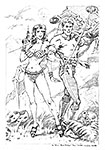
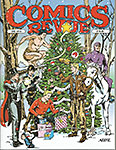
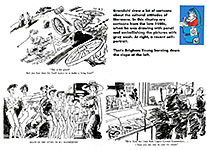
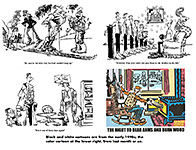
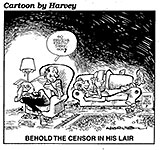
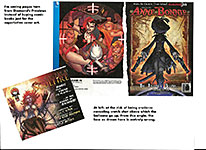
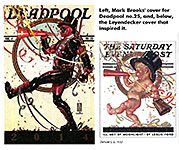
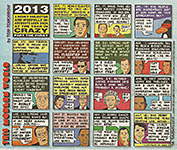
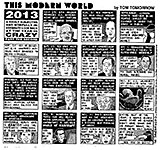

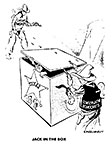


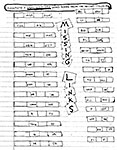
1.jpg)
2.jpg)
3.jpg)
4.jpg)
5.jpg)
6.jpg)
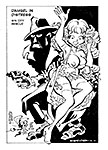
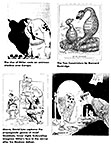
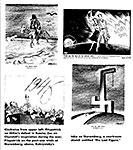

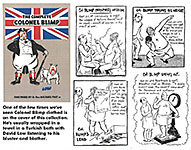

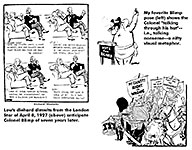
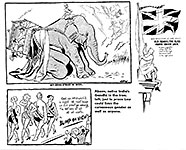
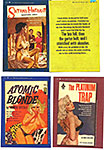
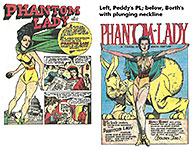
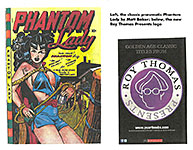
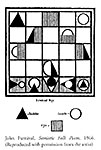
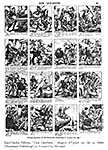
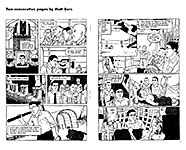
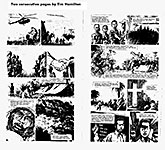
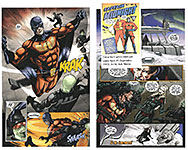
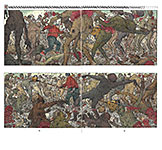
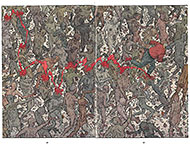
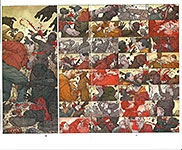
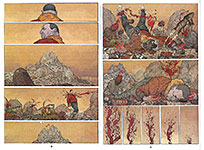
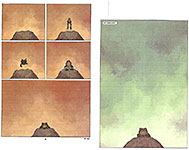
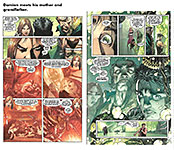

.jpg)
